Awhile back Dan dos Santos got a bit of a roasting in a BBC article, not by name, but not exactly anonymously, either. There was much talk and debate among artists after the piece appeared. My first reaction was, “What?” I didn’t see Dan’s cover for Alien Diplomacy (done in collaboration with David Palumbo for DAW Books) as being offensive, but actually as rather funny. How else should I take a heroine in a little black dress kicking serious robot ass? If she had been wearing a kevlar suit and combat boots it may not have been trotted out as an example of sexist cover art by fantasy writer Jim Hines’ silly blog photo and subsequent BBC essay…but would it have as effectively portrayed the character and conveyed the flavor of the book’s content? Questions the article does not ask.
Oh sure, sexism in the arts, genre or not, is as fair a subject for debate as any, even if you’ll never be able to have a consensus when everything boils down to a matter of taste. And, sure, it’s true that throughout the history of the genre there are more than enough puerile depictions of women to keep Mr. Hines posing in his boxers until doomsday.
Similar concerns have been expressed about comics characters in the much harder-hitting—and infinitely funnier—Hawkeye Initiative website.
Putting aside the fact that artists always have and always will draw, sculpt, and paint people in all sorts of poses in all manner or dress and undress, either for commercial or gallery work, “genre covers” is a subject recently on people’s minds and a news story about it is just as valid as any other.
But unless I’m missing something, here’s the thing that bugged me about the BBC article and Hines’ cosplay: the artists get the “blame” for what appears on the books’ covers. Not the writers whose stories and descriptions lend themselves to the interpretations being decried; not the publishers, not the editors, not the art directors, not the sales reps, not the retailers, and not the consumers. All of whom dictate what the commercial artist creates and delivers. If they don’t approve, if the artist doesn’t follow direction and give them what they’re paying for, the art is never seen. If the customers don’t buy the books, other solutions are sought. And covers do sell books, much more so than the author’s name (unless your name is Stephen King or Stephanie Meyer): if you think otherwise…think again. A creative director I used to work for had a saying: “The art makes you pick it up, the words make you put it down.” Writers routinely went ballistic when he’d say it, but it was (and is) most certainly true. Cover art’s job is to attract a potential reader’s attention: after that it’s up to the story that the writer is telling to get the sale.
I guess that’s what tends to chap my ass about the BBC article and Hines’ assertions: the knee-jerk reaction to blame the messenger, i.e. the artist, for the message being crafted and sent by others. There seems to be a certain hypocrisy at work, a refusal to acknowledge that when you point a finger, there are four pointing back at yourself. (Make that THREE fingers, unless as John Picacio mentioned, your thumb is magic and can point the other way or you’re sporting an extra digit.) If Mr. Hines wants to talk about the way women have been portrayed throughout genre fiction (or examine some of the wonky views on gender, sexuality, social issues, and politics that writers have posited) that would at least provide a certain balance—but working writers tend to not criticize fellow writers if they can avoid it. They never know when they’re going to come face-to-face with an irate target at a con or SFWA banquet.
Which, again, doesn’t mean that the question of sexist genre art isn’t worth talking about. So let’s ask the questions:
1] Does contemporary fantasy & sf art routinely objectify women?
2] When does “sexy” become “sexist”? When is showing bare flesh “artistic” or “offensive”?
3] Where is the line between “harmless” and “harmful,” between “innocent” and “exploitation”? And who gets to decide where and when that line is drawn?
4] And finally…when did it become okay for reporters to get away with being sloppy with their “facts”? I ask the last question because the BBC article asserts, “The stories of Conan the Barbarian are largely credited with transforming fantasy art in the 1960s. These covers showcased muscled men and servile women, a style that artists replicated in subsequent decades.”
Uhhh. Here are all the Conan book covers from the 1960s (the Buccaneer cover was from the early 1970s). Most by Frank Frazetta, three by John Duillo. Lots of bare-assed, sweaty men, but other than Frank’s Conan the Adventurer painting…where are all the “servile” women?
Anyway…objectifying women. Sexist, exploitative covers. Discuss.


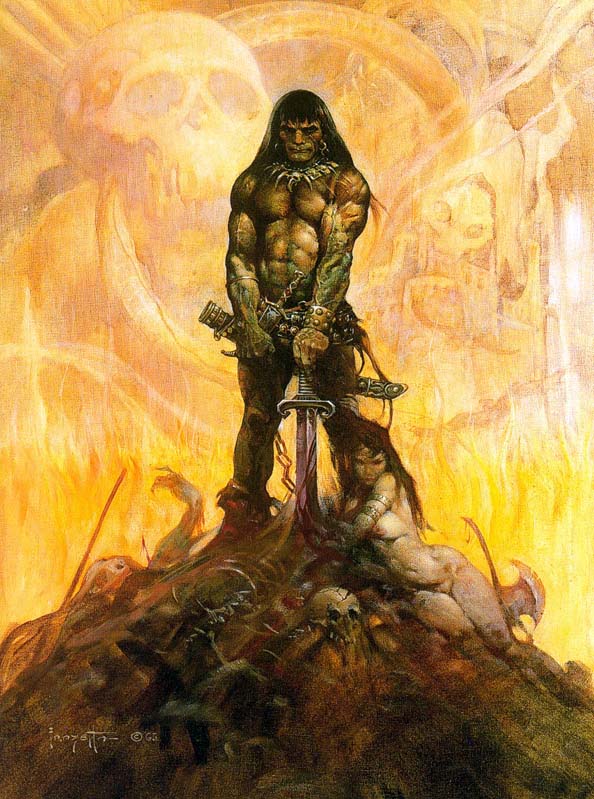
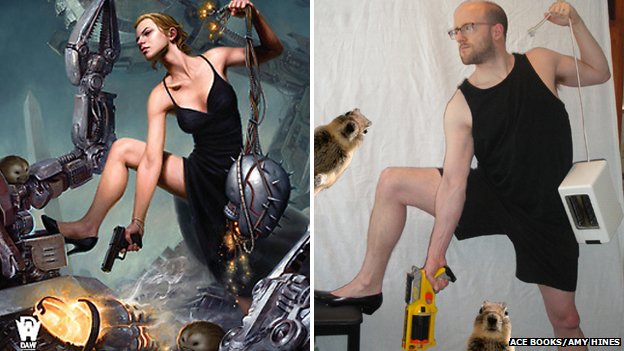

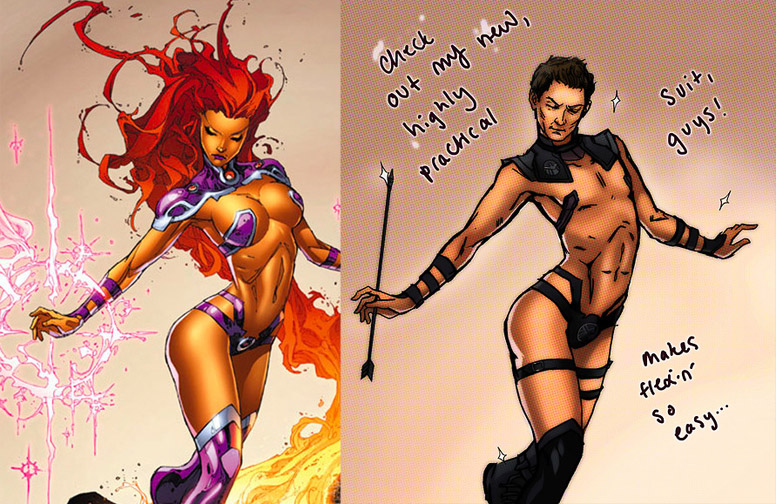

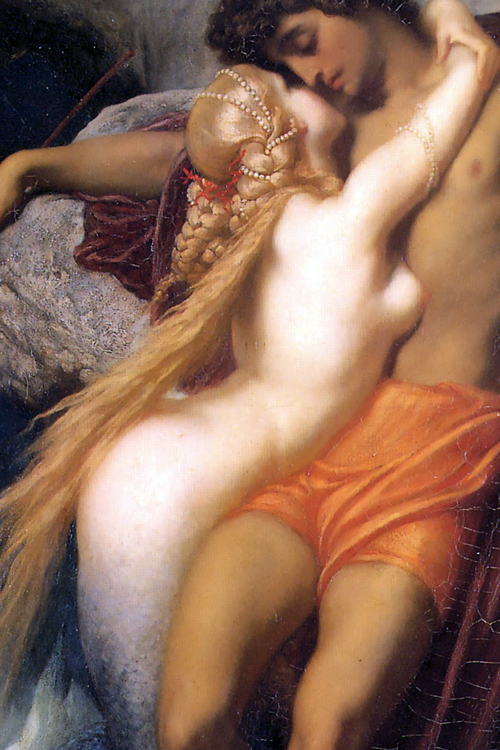
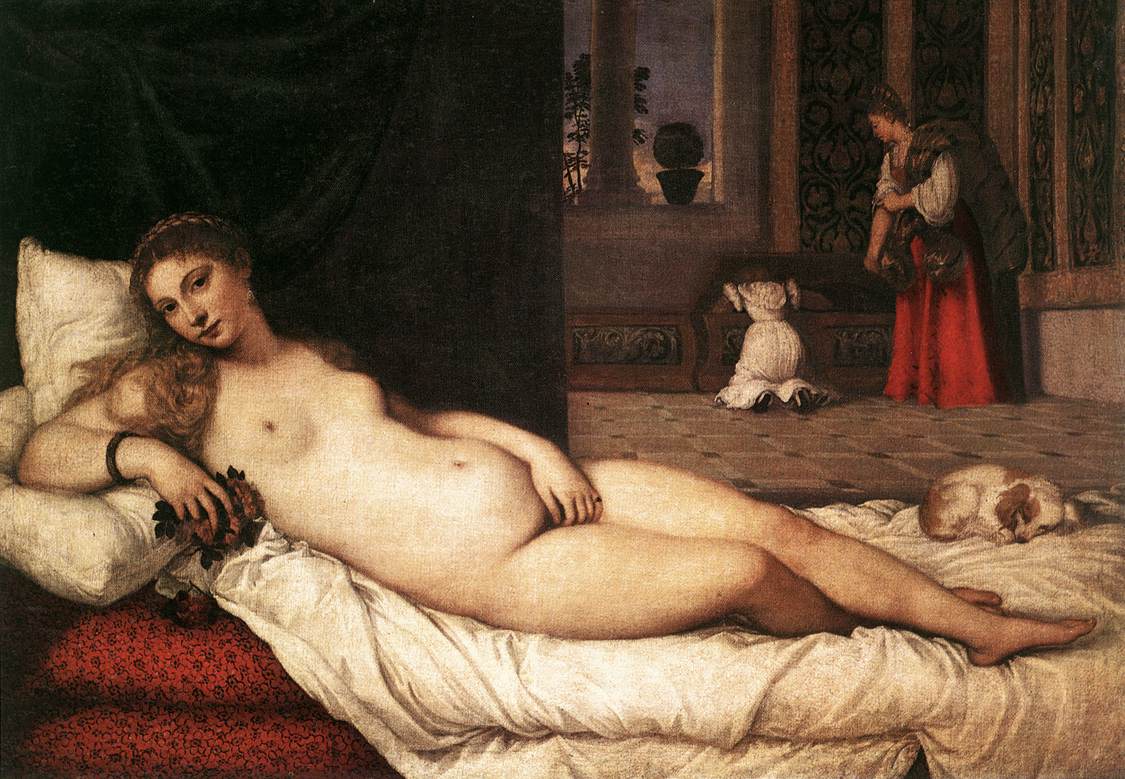
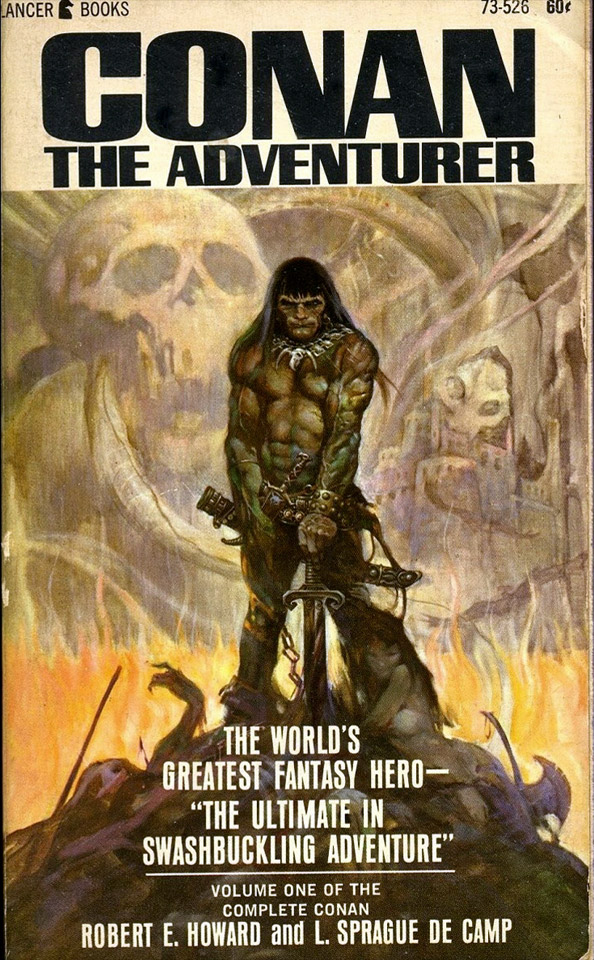
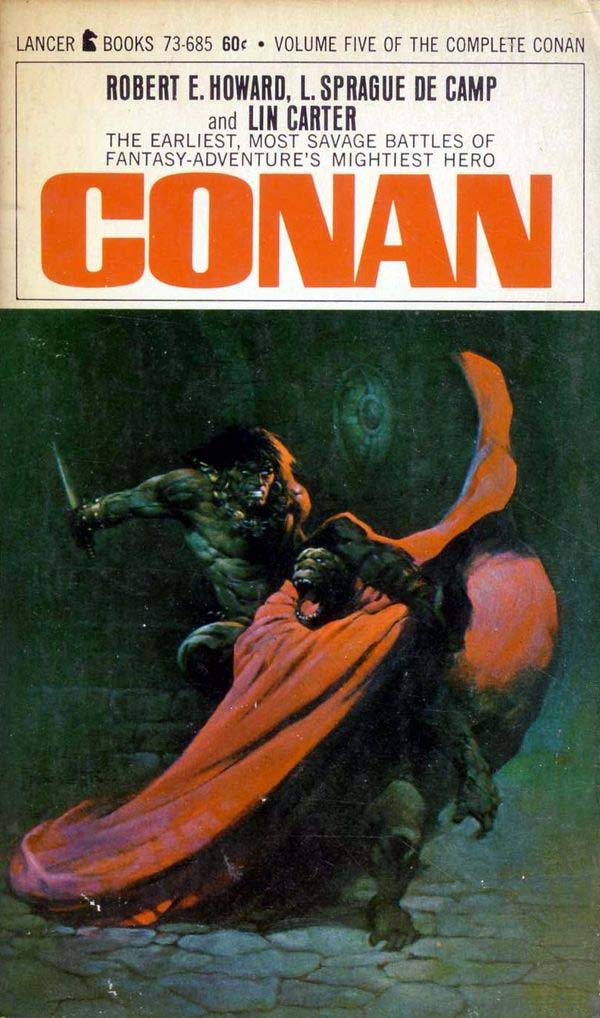
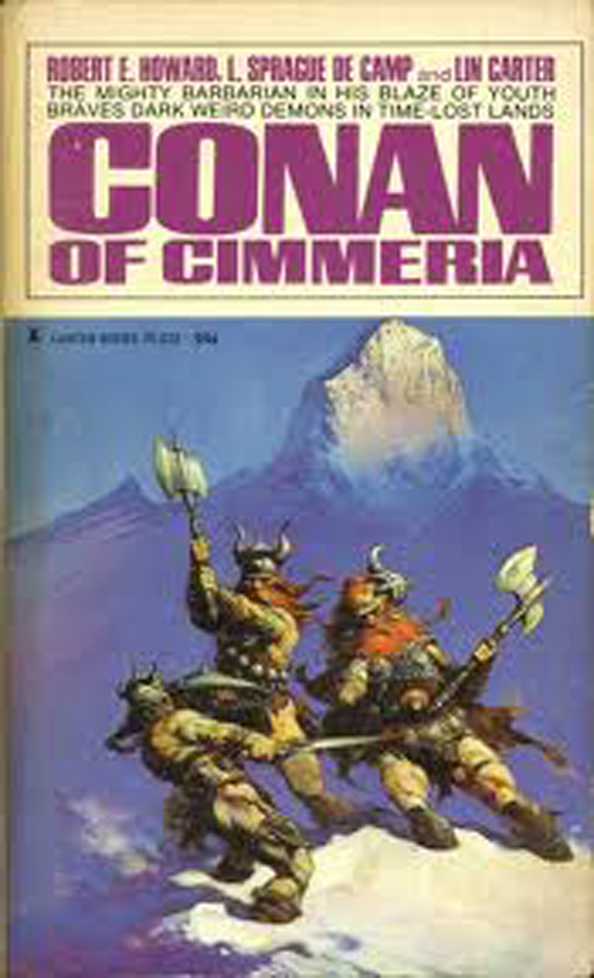
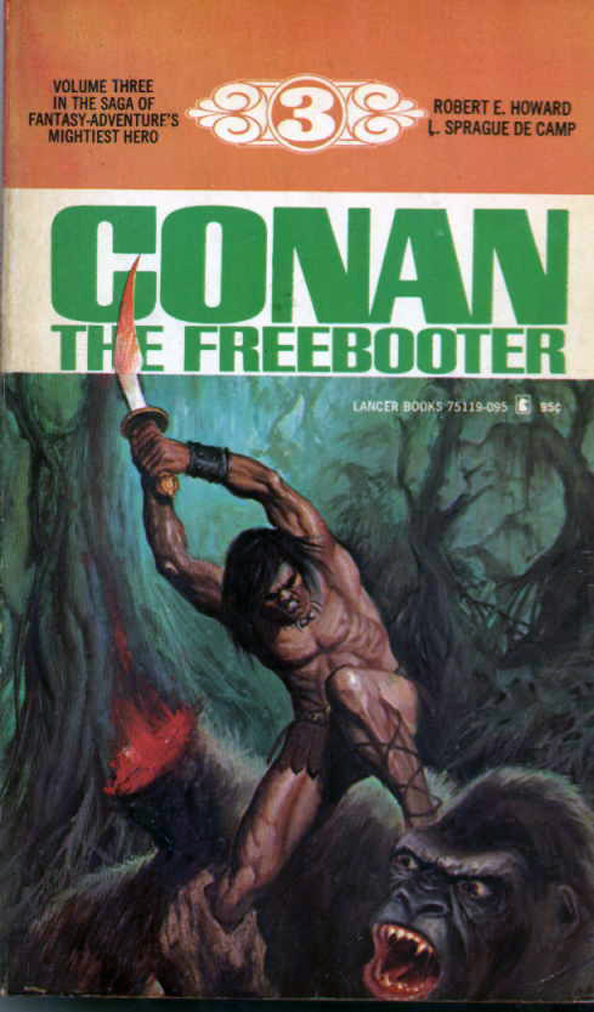
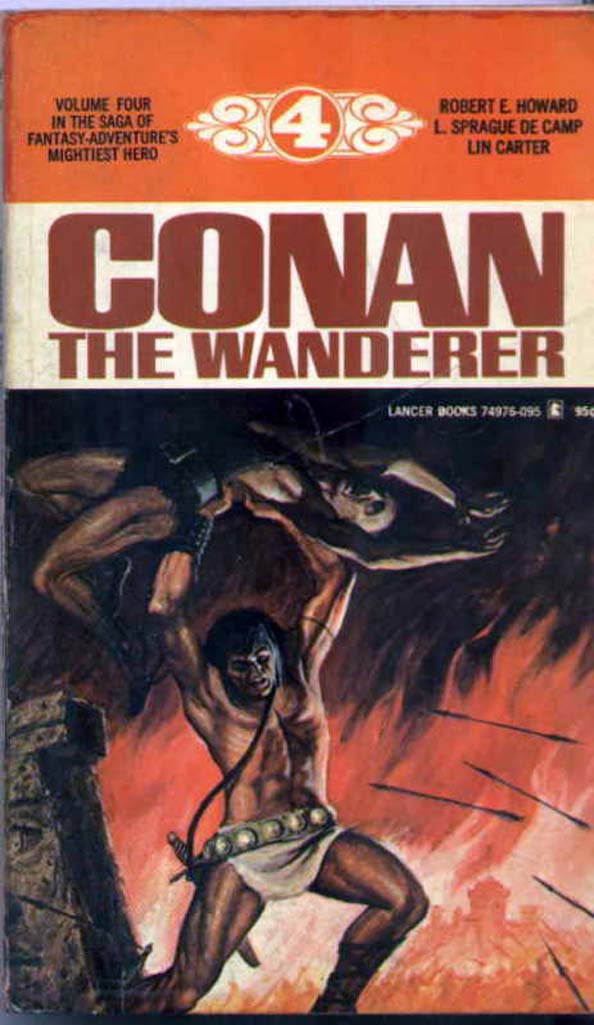
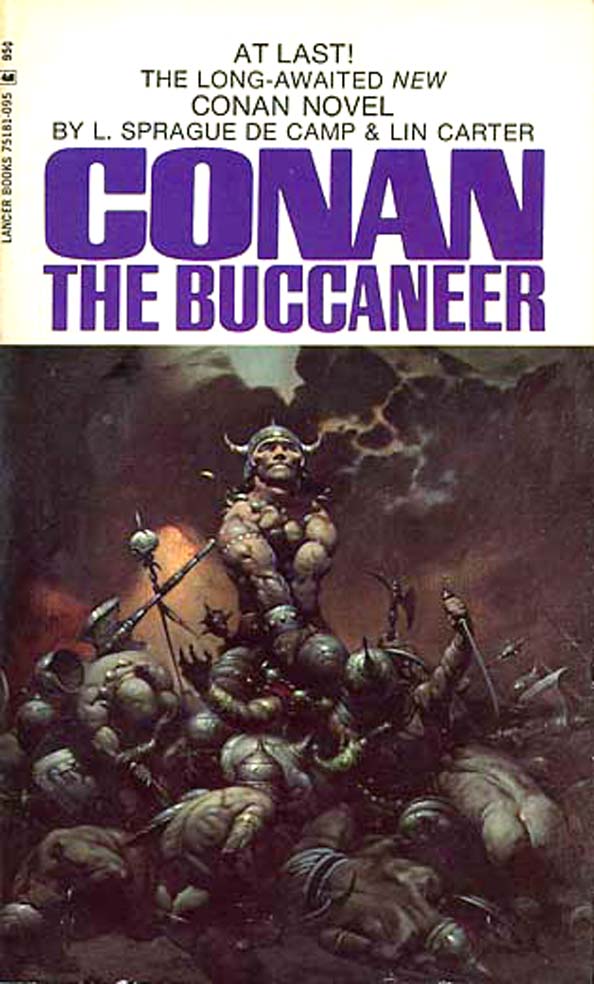
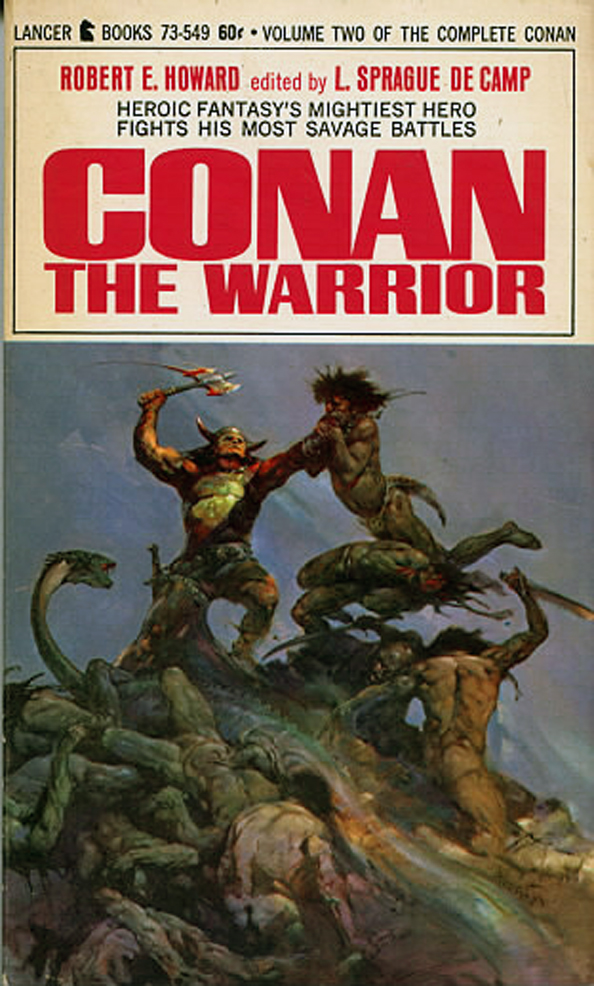
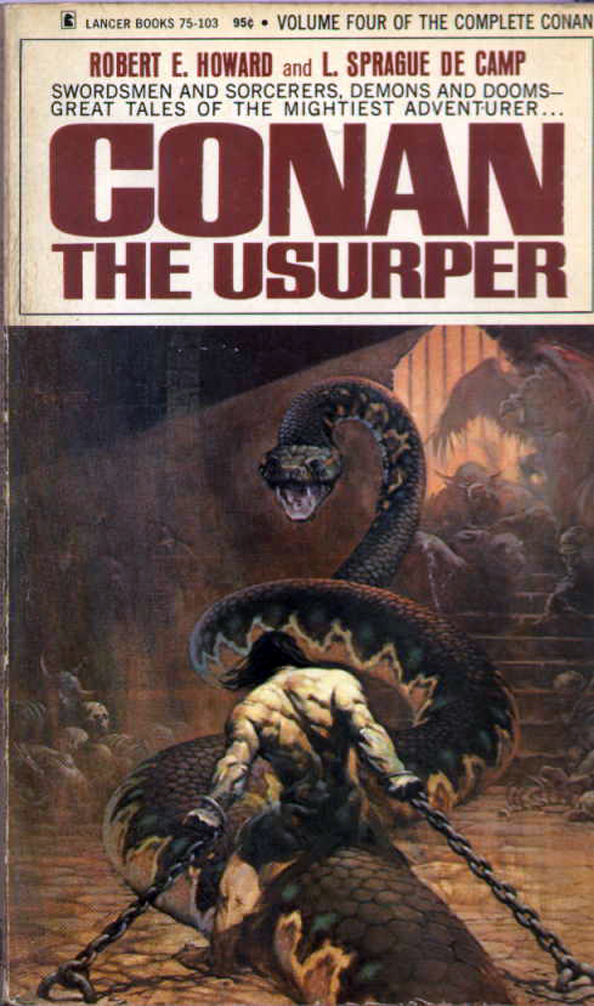
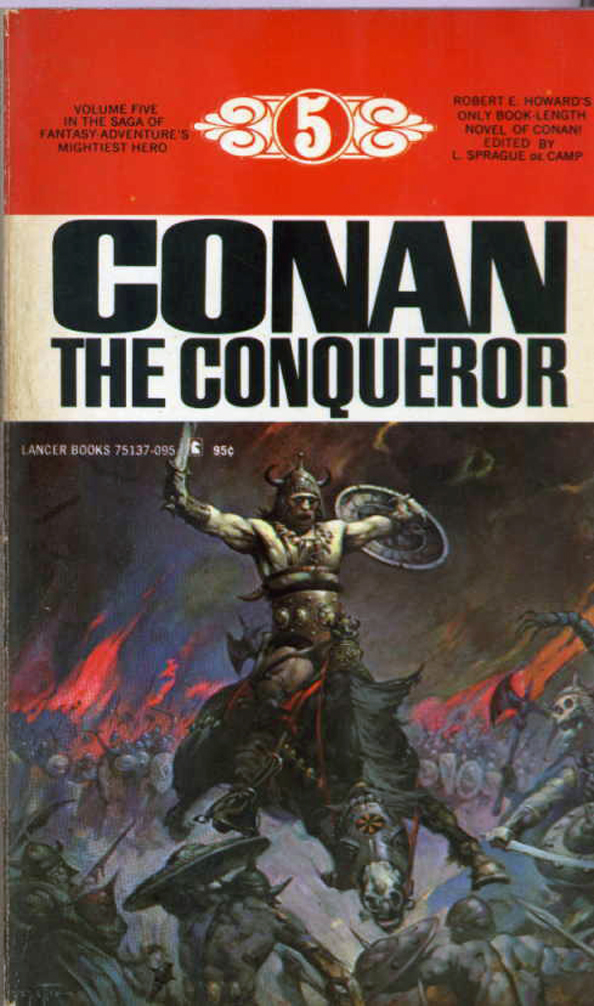
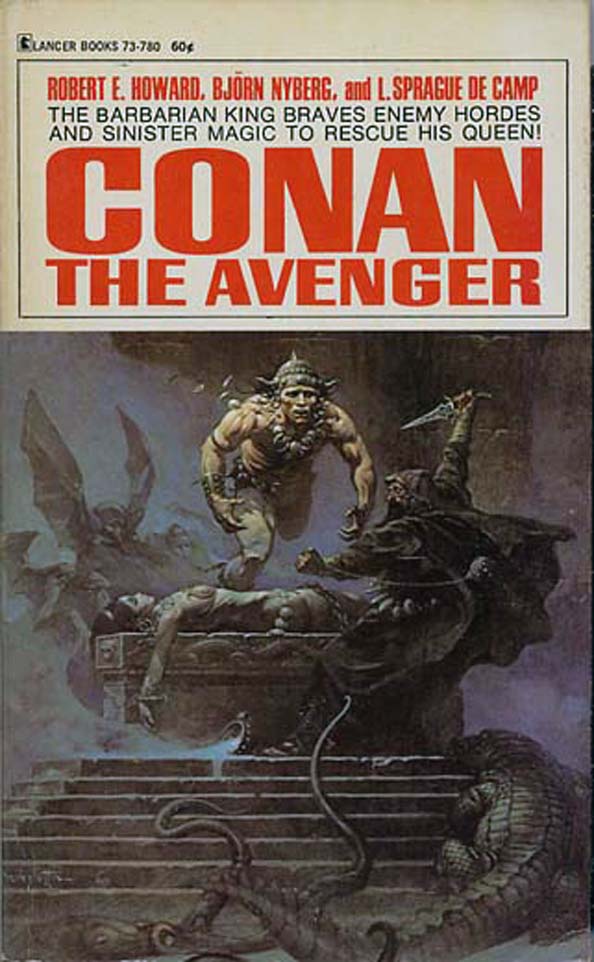

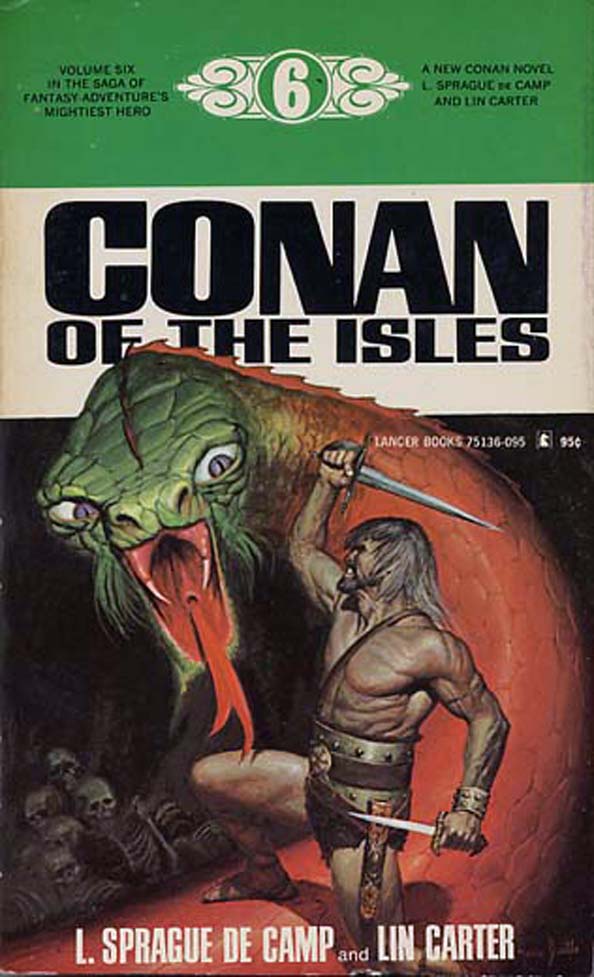
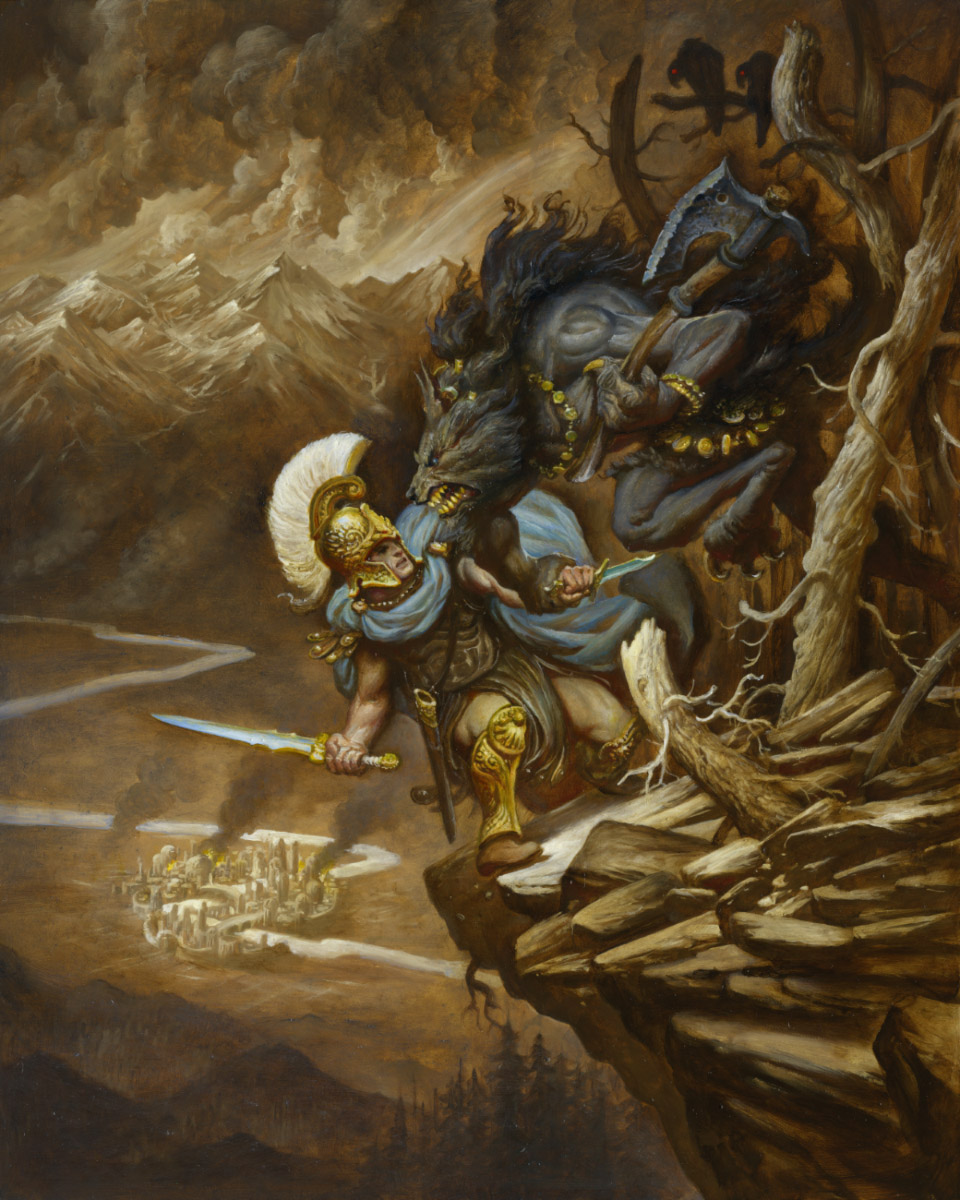

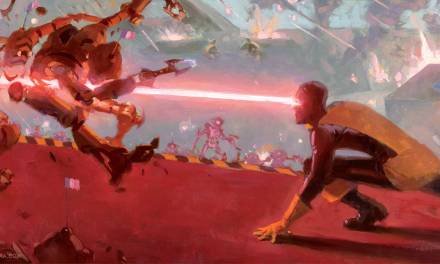
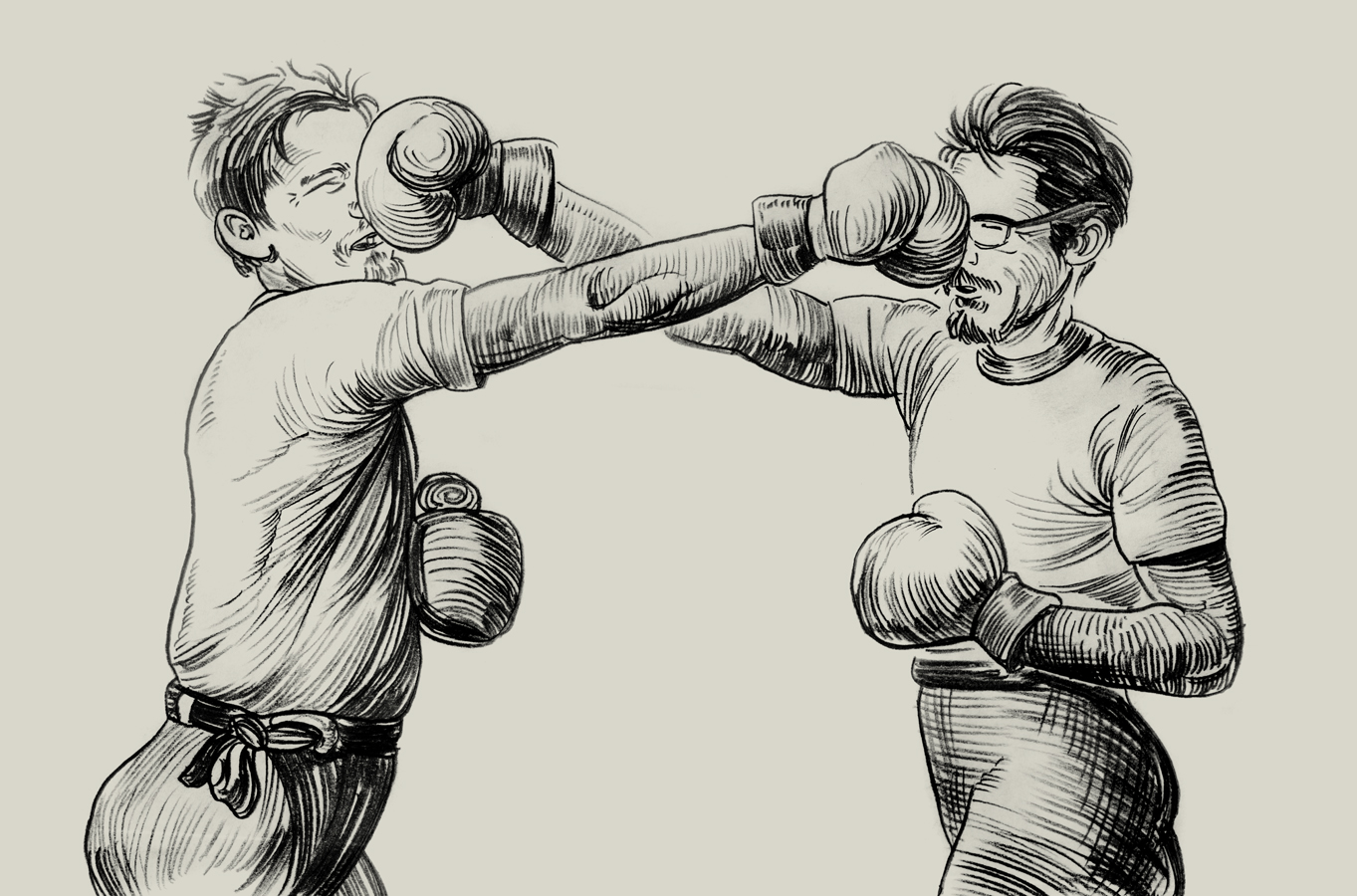

Great post! This topic can become so complex that I can't even string together the proper words for answers to the questions you pose. The human body, both male and female, is an intriguing and amazing and beautiful thing.
If I may however say that Jim Hines is a complete tool. To use that specific (incredible) cover just erased all credibility to his agenda. Think he just wanted to let the world know that his feet actually fit into women's high-heel shoes and that he has very unattractive, knobbly knees. (Have you looked at that freaky thing?!) The squirrels were a nice touch though 😉
There have been three times that an event I witnessed or knew all about ended up as the subject of a news story, and all three times, the reporter had at least a few things wrong — in one case, concerning a prank pulled by some friends in college that made the news, the liberties taken and facts not gathered were truly jaw-dropping. Anyway, thanks to that, I never assume reporters got it all straight…
It's a big topic (one that I have blogged about a few times over at the Amazing Stories website) and one that tends to push people's buttons, but I applaud your post here and am particularly gratified that you have cleared up the misconceptions about the Conan covers. There is one — ONE — out of eleven that depicts a naked woman but that is the one everyone points to. Thank you also for eloquently pointing out that the artist himself (or herself) is not solely to blame for sexist cover art.
As for journalism, well, you know what they say: Never let the facts get in the way of a good story.
1) No more so than the rediculous bodice-ripper romance novel covers, yet they didn't go after that genre, did they? 2) and 3) perhaps when it goes from “thought provoking” to “makes me queasy?” I mean, you look at the James Bond stuff, it doesn't get more sexist than that, but that still leaves me with more of a smirk than true disgust. 4) since Wikipedia started being used as a valid source of information?
I do have a question though – I was reading on a particular SFWA writer's blog that seemed to imply they had no input on cover art – that if, in their estimation, it wasn't eye catching enough, they were stuck with it.
Anyway, I guess everyone needs something to b**ch about and this happened to be the hair in this guy's soup. I actually find it a little annoying and patronizing when men get on the “objectification” kick. We ladies are more than capable of calling shenanigens when we see them and I certainly don't see them in Dan's cover. If anyone broached this subject the “right” way it was definitely the Hawkeye Initiative.
I though the choice of cover in the BBC feature was inappropriate for the point being made. Of ALL the ones they could have chosen for the feature they use one that actually has fun with the central character, where she is clothed, being proactive and also independent. It is reductive to any genuine and valid point being made.
Also, as I said elsewhere, I concur with the point about blaming the messenger: commercial artists work to a brief, not in isolation. I got grief when a cover I did was up against another in a 'best cover of the year vote' on a blog called 'ranting dragon'. Someone needs to explain the concept of 'commercial illustration' to trolls masquerading as critics.
The main issue I take with the article is the idea that strength and sexuality are attributes that can't co-exist in a female subject. I find that one compliments the other expertly in works like Dan's cover above.
“I actually find it a little annoying and patronizing when men get on the “objectification” kick. We ladies are more than capable of calling shenanigens when we see them”
THANK YOU! THANK YOU! THAAAAAAAAANK YOOOOOOOOOOU!!!!!!
Some writers have input on their covers, others don't. There really isn't a hard-and-fast rule and can vary from publisher to publisher, but generally a bestselling author has a lot more say over their covers (if they want it) than their less successful compatriots. There certainly are writers with a strong visual sense who know what makes a good cover, but there are plenty of others who simply don't. In the latter cases it is almost always best to let the people who do art and marketing as their profession do what they're paid to do.
The person with the BIGGEST say these days about what appears on a book cover tends to be the buyer at the largest retail account. Comps are routinely presented to buyers by the publishers' sales reps and if they respond negatively to the art and indicate that unless it's changed there won't be an order…you can bet the publishers change the covers to satisfy the buyer.
I don’t know Hines personally but, to be fair, I think it's clear from his original post that he's talking about covers, not individual artists. He's pointing fingers at all of publishing. I know its made me think about many of the tropes that I had so ingrained in my mind that I never stopped to consider the messages they might be sending.
As you point out, is no one-person with 100% control when it comes to a cover but, the more of us involved the process that are mindful, the better. I may not agree with all of his examples—and I think it's a shame that individuals got caught in the crossfire—but I do think it's an important issue. Is what he's doing a stunt? Yes. But it's made the issue a real conversation across many platforms. (It appears a picture really is worth a 1000 words.) I'll applaud him for that.
You point to the Hawkeye Initiative. For a more positive turn on the issue, there is also the “Women Fighters in Reasonable Armor” blog. http://womenfighters.tumblr.com
Irene
Hey Arnie, great post and extra thanks for that Conan run at the end. Everything that I begin to write in this reply turns into too much of a rant too quickly, so I'll just leave it at that 😉 As to Hines, I traded a few emails and blog comments with him after that article and it seemed there might be a mutual understanding to be reached on the horizon, but I was quickly turned off by watching him slap down or outright dismiss any respectful, well stated comments which challenge his point of view. I remain skeptical of his motives, whatever good may also come of them.
Howdy! Jim the Complete Tool here.
I can certainly understand feeling Dan and Dave feeling stung and pissed off when that cover went up on the BBC article. That said, I've tried to make it clear that I'm not blaming the messenger. Please see http://www.jimchines.com/2013/01/cover-art-wheres-the-problem/ for one example. I've made the point many times that this is an industry-wide, even a society-wide issue, and I'll continue to make that point.
“If Mr. Hines wants to talk about the way women have been portrayed throughout genre fiction (or examine some of the wonky views on gender, sexuality, social issues, and politics that writers have posited) that would at least provide a certain balance—but working writers tend to not criticize fellow writers if they can avoid it.”
Actually, I have talked about those things, though for some reason those posts haven't gotten the same coverage as “Pasty author dude poses like SF/F heroines!” Can't imagine why. As for not criticizing fellow writers, I guess I'm not familiar with that rule. I've criticized authors, artists, and publishers when I felt it was warranted, and I've certainly been raked over the coals by my peers from time to time as well.
Best,
Jim
Its a complex topic to say the least. As an artist I want to be able to depict the female figures I draw with a degree of respect and dignity rather than exploitation. Unfortunately, its difficult to find examples of this within the comics industry that stand out amongst the rest.
Its easy to find poses like the ones at Hawkeye Initiative or Escher Girls to point out how its done wrong. I want to know where I can go to see how it can be done right.
My opinion (for what it's worth) is that by specifically singling out this or that recent cover without mentioning the publishers, it actually does turn into holding individual artists up for derision or criticism. As I said, the way he approaches the subject in his blog (and is followed in the BBC article), Hines (perhaps inadvertently) engages in something of an artist-focused a blame game that ignores the realities of how a cover is created these days. He becomes something of an art critic and takes issue with the way female characters stand or sit (even when they don't generally appear to be sexualized or objectified) while ignoring similar “unrealistic” poses displayed by male characters on book covers. His assertions sort of come off as a shotgun approach to the subject, and while he occasionally hits the target, he also misses the mark frequently and hits others with stray pellets (as I think he did with Dan's piece).
http://www.jimchines.com/2012/01/striking-a-pose/
http://www.jimchines.com/2013/01/group-cover-pose-reveal/
I don't question either his cause or his motive—and I wholeheartedly agree with you that the more we talk and the more mindful we are in publishing, the better. But it I think it's also true that sex permeates the culture and is reflected in all aspects of entertainment and publishing. Women AND men are routinely objectified, in art, photography, and film. I was going to include a batch of Cosmopolitan and romance covers as examples of intensely sex-focused publications largely produced by women for women, but figured that would add just another topic of debate to the post.
Thanks for the link to the “Women Fighters…” site! It's great! Though as a rule sex and nudity don't bother me in the least, some of the damn dumbest things I've ever seen are the Red Sonja in a mail bikini paintings. Yesh.
It seems to me that a lot of people are missing the forest for the trees here. The point is not “There shouldn't be sexy and attractive women on SF novel covers,” but rather “Why are women generally portrayed as ludicrously-posed, passive sex objects rather than protagonists?” The whole point of both Hines' photos and the Hawkeye Initiative is that women are not treated with the same respect and just plain common sense that men are in these illustrations.
I don't think it's unrealistic or unfair to point a finger at the artists creating these works. If illustrators are depicting women this way because they're being told to by their editors or the authors whose work they're illustrating, they ought to say so. But eight times out of ten, what I hear artists say in defense of their work is “I can't/won't draw unattractive women” or “There's nothing wrong with cheesecake.” If it wasn't so ridiculously omnipresent I don't think it would be such an issue, but there's no avoiding it if you're a fan of genre fiction.
It's especially galling in a subculture/community that seems to pride itself on being open-minded and progressive to see depictions and attitudes toward women that wouldn't be out of place in the 1950s.
I absolutely believe that an artist is responsible for his own work. Yes, the client can definitely say what they will pay for but the artist is 100% responsible for providing it. Sex and violence sells but however nicely you dress it, it's still just yanking the most basic urges of people. If that's what you aspire to, then great. And I'm not directing this at anyone specifically. I have high respect for all the artists of this blog.
1. Does contemporary fantasy & sf art routinely objectify women? Are you kidding me? SF&Fantasy art as a genre is a fleshfest. Just look at how many of the spectrum or whatever highly respected SF/F art publication's pages have sexually depicted women on them. There's no reason why female armor only covers nipples and genitalia (although also directs your eye to those parts conveniently).
2. Sexy becomes sexist when one sex is routinely treated differently from another. Sexy and sexist are not related. The offensiveness of sexism is up to the morals of the viewer. Showing bare flesh never makes a piece more artistic, the artistic content of the piece does that. There are many ways of being sexy, many SF/F artists go for the most obvious one.
3. Harmless / exploitation is tricky. Of course, a single cover with a skimpily clad female hero does not matter much but when that depiction becomes the norm, we are talking about shaping the way we see women, the way we see the role of women in our society. If you paint a cover with a female character who is depicted sexually, do you ask yourself: “is sexuality integral to this character and what she is doing? Would I depict a male character in the same way?” If not, the depiction of women sexually is the default and I would have to ask why is that? This is an ethical question, market values do not enter the equation. Is the role of a woman always to be the object of the sexual desire of the viewer? You can't say that about the men. There are too many exceptions.
4. Yes, reporters are sloppy and they are most likely talking about the Conan comic book covers from the 70's which came well after people were already used to identifying fleshy covers with fantasy. It's not important who started it, it's important that we acknowledge the situation we're in. The particular cover by Dos Santos is by no means one of the worst offenders, and not even in the middle of the pack. But the culture as a whole is definitely biased and it is very easy to find imagery that is basically Playboy material.
When I did a quick google search for “Conan book covers”, this image is the first one that showed up:
http://img.photobucket.com/albums/v388/mousemouth/R0014257.jpg
and this was the second:
http://xbox360media.gamespy.com/xbox360/image/article/816/816481/conan-20070828031346944-000.jpg
Both of them contain the servile women poses…maybe the BBC writer didn't do his research well enough, or mistook the Gor series cover art for Conan from 1966, like in this instance from the '76 reprint: http://upload.wikimedia.org/wikipedia/en/9/9a/Tarnsman_of_gor_vallejo_cover.jpg
Regarding the beautifully created illustration for “Alien Diplomacy”, the publisher creative/marketing team evidently pushed the artists to design a different costume than what was actually in the story. I checked the source and the only similarity to that dress was that it was black — it was supposed to have a “modest” top as the character complained that otherwise the security men she was working with would be staring at her cleavage all night. The shoes were supposed to be low-heeled in order for the character to run as she anticipated trouble. Sure, the “contrast” of the character in high heels with a “little black dress” and then battling robots could be funny to some, but I suppose that the humor and the contrast in that was lost because most of the other cover art already has women posed and dressed like that on the cover of other unrelated SF/F books even when their content isn't of a similar “pulp” nature.
One of the main complaints related to the objectification of women who are portrayed on SF/F book cover illustrations is that men are *always* portrayed in a position of power, while the majority of women on the covers are evidently *always* supposed to look sexy, not necessarily powerful. Why otherwise is a female character so often portrayed with her shirt or uniform unbuttoned and unzipped (or torn) to reveal cleavage, the “broke back” pose used, the “come-hither” gaze, etc. when she's on the cover? Etc., etc…blah, blah. Others have gone into much more depth about that on other forums, but then you’ll still get comments like this: “The politically correct police strike again, it seems. Soon all books will be sold with blank covers with only the title and author's name on them… see the artwork as a bit of fun rather than a realistic depiction.” Personally, I’d much rather have beautiful art and design on book covers, if only those tropes weren’t used so often….
I've been reading SF/F since the mid-seventies, so it's been interesting (and irritating) to me as both a reader and then later as an artist to see how some elements have changed while others have definitely not. Or not enough…thinking of the popular “tramp stamp” and rear view poses with exposed midriff in so many paranormal/urban fantasy stories…that's supposed to signify a powerful and interesting female main character and an intriguing story…to women readers? I've picked up SF/F books more often in spite of the cover lately, rather than because I was intrigued. Or, since I've read so many books, it was because I liked the author's writing already or was recommended the book or series by friends who share my interest in the genre, or finally by a reviewer or other author I appreciate.
Also, I totally agree with Irene's post above, and look forward to seeing what changes occur in the future of SF/F book illustration from the publishing team and creatives, if any, from comments and discussions like these, and the influence of “Women Fighters in Reasonable Armor” and other similar blogs. 🙂
Well, this audience is pro-objectify. After all, isn't that the point of a cover, to distill 150,000 words into one compelling object? That, essentially, is objectification: to present something, whether a woman, a man, or a book’s contents, as an object. The makeup of that object is critical to book sales: If it doesn't turn heads, it doesn't sell.
I'm a bit concerned when persons in the advertising world (like us) claim exemption from any linkage between images like you see above, male and female, and those used to promote the $14 billion/year porn industries and the $32 billion/year human trafficking industries and their costs. I mean, “It’s just business, isn’t it? I didn’t make the marketing decision”.
While you cannot factually prove such linkage, a few moments spent counseling obeservably sexually-addicted teens, or girls under unbelievable pressure in lunchtime high school parking lots, or women abused because they are unable to meet impossible expectations, or men who are trying to stay faithful to their wives while still being steeped in this kind of imagery – counseling with them about the origins and expressions of their addictions does clarify things. We all have to draw our own lines. Did Dan Dos Santos (to continue the analogy in this blog) know he was creating potentially alluring or offensive material in the subject image above or for the “White Trash Zombie” series, among others? Was that his goal and the goal of his approval chain? He is lauded and excoriated for the results, which makes for good press, almost always a plus from an advertising point of view. What are the consequences? Are there any?
Recommended reading: “Protect the Children”, http://www.lds.org/general-conference/2012/10/protect-the-children?lang=eng
Jim–
Thanks for weighing in and for the link to your other blog post. Much appreciated!
Here's the thing, though: none of the “blame-sharing” you rightly wrote about in the link was really included in the BBC article. When you (or they) hold up the art beside your parody without mentioning the publisher responsible (your own publisher, though not your book, in Dan's case), everybody else sort of gets a pass and it's the artist that is left to twist alone in the wind of public derision. Which comes off as even more unfair if you follow the link back I included to Dan's post about the creation of the cover: looking at his sketches show that someone else decided on the direction the final went in. (Again, not that I see anything offensive with the final cover.)
I view the lack of context as unfair and harmful. And that's the reason for the post.
Having been friends with many writers over the years, I know that they generally “tend to avoid” criticizing each others' work publicly these days. (I'm not counting reviews.) Privately (or semi-privately in closed forums) they can fight like cats and dogs–but only rarely does it boil over into a public blood-letting. It seems that the time-honored game of let's-you-and-him-fight is at least a little less popular than it once was–or maybe I've been missing the fisticuffs. If you've been taking fellow writers to task (including some Hugo and Nebula winners) for fictions that include rape fantasies or homophobic rants or fascist screeds, please share the link. I'd love to read them.
Thanks again.
“thinking of the popular “tramp stamp” and rear view poses with exposed midriff in so many paranormal/urban fantasy stories…that's supposed to signify a powerful and interesting female main character and an intriguing story…to women readers? I've picked up SF/F books more often in spite of the cover lately, rather than because I was intrigued.”
You've nailed the problem right here, Tanya.
You buy the book with the midriff on it because you KNOW that's the type of book you like.
The artist doesn't want to paint that stuff, the author doesn't want that stuff, the ADs don't want that stuff…
But the buyers know what they are getting when you paint that stuff!
Portray something different, and you risk the book not attracting the right kind of audience. Risk is not something Publishers like.
The real problem is that all these cliches have become a shorthand for a specific genre, a shorthand that serves a purpose.
If I put a couple in a clench on a cover, it wouldn't matter if they were wearing space helmets or cowboy hats… it's still a romance cover. Women who buy romance novels will pick it up… not Western fans.
I specifically think of the Twilight series when this comes up. If the cover designer actually portrayed a bunch of Vampires fighting an enormous battle against a bunch of Werewolves, that cover would would look just like every other D&D/Fantasy novel out there… and the majority of women would glaze right over it.
Yes, we can change what cliches we use on the covers (and perhaps Hine's actions may help us do just that), but ultimately, they will just be replaced by another cliche. We need them. It's branding.
Hi Arnie,
That's a fair point, and something I struggled with over the past year. In my own mind, I have ALL THE CONTEXT, so of course I know what I meant. Most of my regular readers who have followed the project since last January have gotten most of that context. But you're right that much–even most–of the context gets lost when people hear about the pics and poses from the BBC or the Guardian.
And while I'm very proud of the cover posing fundraiser we did in December, that also had some drawbacks. The focus on raising money for a good cause took away some of the nuance of the conversation. Looking back, there are definitely some things I would have done differently.
I'm trying to listen to the feedback, and to incorporate it into the discussions. I've got an article for the next issue of the SFWA Bulletin about cover art, and I very deliberately tried to stress that this isn't just a “SEXIST ARTISTS ALL SUCK!!!1!!!1” sort of thing.
I do know a number of authors who are uncomfortable with giving public criticism, and I don't think any of us particularly enjoy receiving it. There are times when I'll talk to someone one-on-one, but I also think there are times when it's important to say these things publicly. As a few examples…
http://www.jimchines.com/2011/12/well-tempered-clavicle/
http://www.jimchines.com/2012/08/thoroughly-nonracist-nonsense/
http://www.jimchines.com/2011/06/sex-vs-rape/
http://www.jimchines.com/2011/02/rape-jokes/
I'm not sure about the award status of these writers, and they're not all fiction, but hopefully this is the kind of thing you were asking about?
Hopefully the links won't get this comment trapped in Spam Limbo…
Best,
Jim
“I'm a bit concerned when persons in the advertising world (like us) claim exemption from any linkage between images like you see above, male and female, and those used to promote the $14 billion/year porn industries and the $32 billion/year human trafficking industries and their costs. I mean, “It’s just business, isn’t it? I didn’t make the marketing decision”.”
My opinion is that it's a huge leap to even remotely connect genre covers with the porn industry and human trafficking. I don't seriously believe anyone would describe Dan's cover–or the Conan covers–as pornographic. No one is absolving artists of any responsibility for what they do or for the content of their work; my issue, as I've said several times already, is that covers are not created in a vacuum, than many people are involved. The way the BBC article was constructed, the artists appeared to be left holding the bag alone. They shouldn't.
Thanks, Jim!
Dan — “You buy the book with the midriff on it because you KNOW that's the type of book you like…”
Actually, no — that's when I avoid it. And I was late to reading several authors because of it. I agree with the branding component, though. I just could wish the stories had been branded with a different style of illustration. 🙂
Since the Twilight books aren't shelved or given the same placement (unless it's at point-of-purchase) as the SF/F books that I see in the bookstore (they're usually in the YA/teen section not the SF/F), I can't and I don't believe they should be compared to the typical D&D/fantasy novel, so your statement that “the majority of women would glaze right over it” is moot.
“…artists appeared to be left holding the bag alone. They shouldn't.” Agreed. They are part of the group holding the bag. Their work is most visible and therefore the easiest to target; the collaborative process that helped shape that work is less so but still shares the blame.
I do believe that Dan's covers — and Frazetta's and many others, not to single out Dan — are pornographic. Not explicitly, but on the edges. The definition is a sliding scale, depending on your experience, but if you go with the definition that pornography is “the explicit portrayal of sexual subject matter for the purpose of sexual gratification” then I think most fantasy covers would qualify. They certainly would on the “sexual gratification” aspect alone. How many barbarians wander around in the snow in a loin cloth? How many soldiers today would show up for a sword fight in a bikini? Yes, Dan’s cover above is only slightly pornographic from today’s perspective, not explicit in any way, but the elements are there. Not many decades ago, that cover would have been considered explicit.
I was young, once, several centuries ago. When I looked at Frazetta’s covers, male or female, my response was hormonal, loud and clear. That was the marketers’ intent. It was that hormonal rush that pushed me to buy the book – I was hoping to find more. To that degree, the marketers achieved their goals. But they were also shaping me.
Those small steps are what lead to the society-wide mess we are in. I think most women would be offended if you told them that in order to be seen as strong they have to be young, gorgeous, show a lot of leg and cleavage, have great hair, a “come hither” look (pornographic essentials) and — oh, yes, hold a gun. Are they “powerful” because they have great muscles and want sex? I think most women would rather be seen as attractive regardless of their looks or age and seen as powerful because of their actions or ideas or attitudes or sacrifices; I think men would wish to be seen the same way. When we say a person’s power lies only in their looks, that is being demeaning, that is being very harmful, and that is a form of pornography. The cost of those depictions is something we are all paying for, and for which we all share some blame.
To those that don't know — I love Arnie like a brother. If I didn't already think he's done more good for the sff illustration community than any one person, I'd still have deep respect his opinions as a dear friend.
Arnie, I do thank you for opening up the conversation here. While the debate has been going on long before the BBC article, you've likely opened it up to more artists here than any other platform could.
Sex and nudity don't bother me in the least either. But those things aren't sexist as a rule. I know _you_ aren't saying that but it's often the first assumption often made in this debate. Hell, I don't have a problem with pin-up or cheesecake art…with the big caveat that the people creating and consuming it need to understand exactly what it is. The problem is that people are so unaware of what they are often saying or hearing. Women as well, as you mention here.
And that's my biggest take-away from Hines' stunt. A simple: take a look and consider what it is we are doing. See it fresh. Sometimes it'll change my mind and sometimes it won't, but it's worth the consideration.
As for the “men are objectified too” argument. They are idealized, yes, but usually to a crazy degree of competence and power, not as an object to be conquered and obtained.
I do wish the conversation could be done without targeting individuals. There has been a number of issues that people have flung arrows at Tor and Tor.com about. While it stings my personally, it doesn't make the criticism wrong or right as a whole. I'm forced listen and privately gnash my teeth while understanding that it's a complicated world and I believe we do a lot of good on balance. (I know it's easier to do as one-of-many in a corporation but, rest assured, I take anything said about Tor.com as personally as any artist does about their work.) Which is my long winded way of admitting that I'm throwing stones from a glass house…while hoping to build better houses, where I can, with the help of others.
Which _really_ means the best thing I can do right now is, get back to work! Now, where's my Spectrum 19…..
It may obviously be different in other countries, but around here the Twilight books lord over the sf/f shelves, right next to Pratchett and Tolkien.
Oh the horrors fantasy book covers cause! Who would've thought?!
I have to disagree with you, Lester. And I think your overly expansive application of the term “pornographic” is misapplied and undermines your argument. Regardless of poses, regardless of attire, regardless of the presence of female or male nudity, I don't believe the vast majority of people would consider any of these covers as pornography. I know that I don't.
But I think this also gets away from the questions I've asked. ARE f&sf covers routinely sexist these days or is it simply a perception that they are, based on the genre's history and a proportionally few contemporary examples? (Comics…well, that's another issue. But I don't think society's ills can all be laid solely at the spandex feet of Catwoman or Storm either.)
LOL! I agree, Jan. Who would have thought the impacts of such simple things, one silken thread at a time…
Thanks, Irene! And for those who don't know, I always introduce Irene to people as “my little sister” (which makes them quicky pull her aside and privately express their sympathy).
I knew that there had been a lot of talk behind the scenes among industry folk after the BBC article appeared. Greg Manchess (who I regularly introduce as my “crankyassed significantly older brother”) and I had a talk about how the B&D 50 Shades of Gray books had been successfully marketed to a primarily female readership with covers that studiously avoided letting on what they were REALLY about (making them “acceptable” to read in public).
As I mentioned to Jim Hines, it was the lack of context that I felt unfairly left the artists alone in the critical headlights. Dan had been taken to task once before by a critic who equated his depiction of a character with tattoos with the ills of modern society, again as if he was calling all the shots and making all the decisions without the client's input. So the whole idea of this post–besides taking the opportunity to shoot off my mouth–was to get people talking. I'm a firm believer that good can always come from a civil exchange of ideas. Nobody has to change their minds, but listening can lead to…who knows? And hopefully people will realize that a lot of factors go into the creation of a book cover these days.
Hey Jan, that's interesting placement…it sounds like your local store in the Czech Republic (going by your profile) doesn't have a separate teen or YA section; however, the Czech Twilight cover
(http://kalebnation.com/wp-content/uploads/2009/01/twilight_czech.jpg)
is also rather different than the US treatment, maybe because it does have the broader SF/F market to compete with…like those D&D/fantasy books Dan mentioned. 🙂
Thinking of the D&D covers, also had me thinking about the Game of Thrones, current editions. How the HC versions out now have the symbol or icon artwork and design instead of figurative illustration…maybe because it's also trying to appeal to a broader market, most of whom are already familiar with the content of the stories because of the HBO series. Or are they avoiding the sexy moments which include just about every adult character in the books at some point or another, together or separate. However, the first book had a nice introspective illustration focusing on Jon Snow and his dire wolf, Ghost. It makes me wonder why we haven't seen a topless (or implied) Daenerys Targaryen on the cover yet(like the Jacquiline Carey Kushiel books) because isn't that typical for the genre, or will that be reserved for one of the issues in the comic adaptation…ha.
On the one hand, “yay” for not using the Gor style of pulp covers because that isn't entirely what the stories are about, but I do miss when there isn't interesting (not sexy) figurative or portrait illustration because the art can be beautiful and give us an artist's inspiration of the characters or key scenes in the stories. But that's part of what made John Picacio's GoT calendar so cool.
Pornographic is an arbitrary line defined for each by background and culture. This discussion is all about a cause and little about reality. Being in academics forever I have heard and participated in this kind of discussion from every angle except the most important. That of a woman. And from women I have heard heated and cogent arguments from numerous angles including polar opposite sides. The thing is, it will always be nothing more than an exercise because of money. Commerce will continue to dictate what goes on covers and what makes money at the theater. We, as individuals, can draw our own lines in the sand according to our own consciences but it will always be for our own enrichment and benefit.
But the reality is that even knowing what's best for us or for a community and culture as a whole has little to do with how we act. Does that mean that we shouldn't visit these issues and have academic or intellectual discussions about them? No, but we can't even come to a consensus of the “powerful woman” look so what is the common goal?
I get what you're saying, Lester. It's no secret that I, and many others, are using sex as an advertising tool. Maybe we aren't showing anything explicit, but we certainly are implying the notion of sex a lot of the time. I'll accept that.
But what I don't get, is why that is bad.
Sincerely.
It's one thing to depict someone as SOLELY a sex object, void of other qualities. Or to depict them as weak, and thusly to be used sexually as you'd will. But I do not think the majority of covers do that. These are not helpless women.
I don't think sex is the problem. Just because something is sexually desirable doesn't make it evil. After all, isn't that the entire basis of natural selection? Being sexually desirable is something everyone wants to be.
For me, the trouble lies in the tropes that we use to depict that sexual desire.
'Power' should NOT have to be indicated with guns.
'Sex' should NOT have be indicated with boobs.
But the sad truth is, those are the EASIEST solutions when working pictorially, and as a result Artists, Art Directors, and Marketing Teams all rely on them heavily to get the job done.
I won't rehash everything because the posters before me did a really good job of explaining how I feel.
Especially Devin: “The point is not “There shouldn't be sexy and attractive women on SF novel covers,” but rather “Why are women generally portrayed as ludicrously-posed, passive sex objects rather than protagonists?””
I wanted to comment specifically about the cover:
“I didn't see Dan's cover for Alien Diplomacy (done in collaboration with David Palumbo for DAW Books) as being offensive, but actually as rather funny. How else should I take a heroine in a little black dress kicking serious robot ass?”
The cover is beautifully executed but contains deeply ingrained social inequality. What I think Mr. Hines is trying to point out is how deeply sexist the posing of the figure is. We as a society have been so thoroughly trained to depict women a certain way that most people look at that cover and see nothing wrong. What is wrong? She isn't kicking serious robot ass is really the problem. If a guy were on that cover he would be tearing some shit up but it is a girl so she is standing there, in a skimpy dress, with a mostly detached facial expression, striking a supermodel pose. It looks like a photoshoot not a battle.
Just my take on it, no disrespect.
“But I do not think the majority of covers do that. These are not helpless women.”
Very often women are portrayed with vacant million-yard-stares. Combine that with an impractical pose and revealing clothing and you get “SOLELY a sex object, void of other qualities.”. Even if the actual CHARACTER is a strong woman, the image is just a sex object at that point.
On the Conan covers, perhaps the “Servile Women” left due to being bored?
I think Jim Hines is just seeking to create controversy to get traffic. Or perhaps he has cross dressing issues?
Commenter Lester appear to have led a sheltered life if he thinks Fantasy covers are Pornographic. Sorry to let you know that scantily clad figures in action poses gets people to look at the book, which is the prime function of a cover.
~John
“Maybe we aren't showing anything explicit, but we certainly are implying the notion of sex a lot of the time. I'll accept that.
But what I don't get, is why that is bad.
Sincerely.”
There is nothing bad about sex in itself. There is nothing bad in using sex in marketing… if it is justified by the content. But selling something non-sexual with sex, is MAKING it about sex. It's selling the idea that it's ok to require women to be sexual in any given situation to be acceptable (let's face it, if this was a problem in the depiction of men, internet forums would look very different). That probably sounded harsh but it's really not about an individual image, an individual artist can't tell half of humanity how to live. But multiply that by ten thousand or even more and it begins to really matter. Those pictures are everywhere selling everything. They affect everyone, men and women alike. Of course, no single artist can take the blame for it all, we're all a part of the process.
I appreciate the sentiment, John. But let's keep it classy. No personal attacks please.
Well, I guess how much robot ass is getting kicked is a matter of opinion. To me, her having blown off its head and preparing to step over it to the next 'bot says she put some kittycombattie on it. And, frankly, if it was a guy in a tux doing the same thing, I would have thought THAT was equally funny.
Well, I saw it coming. People roaring about objectification in movies, in video games, in music and now, of course in this.
While I do understand how a group of people may be “offended”, I don't see why I should care. Let them be offended, nothing happens! Nobody dies or get's sick because they get offended.
And yes, one can argue about the subliminal social implications blah blah blah like the mesmerizing Alpha Waves Coca Cola inserts in their ads to hypnotize you into buying more Coke right?
Groups organize wars, have innocent civilians die, choke honest working people out of their life's work etc so they can gain more power and money, and these groups are comprised of both men and women, yet our worst worry is this first world “problem” of whether the female sex is objectified when a female is posed in a provocative way on a cover? What about the dude who has to go through hell and back, get stabbed, risk death and such, just to save her while she's waiting all comfy in the bad guys' lair? He's a tool also. Besides, most women in real life are thrilled by posing provocatively and attracting male attention. What, did I imagine this? Is biology suddenly fiction?
Solve the problem of why a man is supposed to drown with the sinking Titanic while women get on the life boats, how men get killed in wars while women are back at the base, safe behind a radio screen, how by default (at least where I live) an uneducated female with no work experience can get a job 3 times easier and with more pay than a man blah blah blah, and then we can talk about this fictional problem. In any case, if I had the choice, since socially both men and women are tools, I'd rather be the prize, cause all you do is sit around, preen and take your pick, while someone else does all the dirty work. Like Oscar Wilde said “When a woman marries again it is because she detested her first husband. When a man marries again it is because he adored his first wife. Women try their luck; men risk theirs.”
After all this graphic ranting to get your attention let me get to my point. Nagging about these issues, when their true impact is virtually zero, is easy and useless. Why is it zero? Because traditionally sf/fantasy art is a male dominated hobby. You don't see fantasy enthusiasts running around with swords, grabbing women, throwing them over their shoulder and running to the hills. Yes, philosophizing about such things can be useful, but if one follows things, one will notice that there's a pattern to this.
The few women that supported fantasy fiction through the decades had little problem, and all that did either read something else or made the step (and kudos to them) of writing their own fiction, expanding the genre in ways that are more appealing to them. There is no reason to succumb to female hypoagency just to accommodate people who supposedly like sf/fantasy, but only on their own terms.
Making writers, artists, publishers etc censor themselves, out of fear that some hyperactive, ultra sensitive button-pusher is gonna yell “rape” is not respecting their “right” to not be offended, there is no such right, you can't make an offense out of being offended …What it is is a very subtle ease-in of negating the individual's right to express oneself as one wishes. And that is fascism.
I just hope people understand what I'm saying and don't go to the ad hominem of calling me a misogynist or something silly like that.
Seems like there's a pile of comments allready, so I'm not sure if anyone's gonna bother to scroll all the way down here… but…
“Objectification” and “sexism” are such abstract concepts, and there doesn't really seem to be any concensus about what either really means. Some women get offended when they see picture of good looking women without clothing. Some women get offended for other reasons. (Guess I'm focusing on women here, since that's kind of the issue at hand.) Some women don't care, and simply think it's all good fun. Who's really to blame then? Does the market really need to adapt to and take into consideration the reactions some people have to a certain thing? Is it even the job of the media, and art in general, to make everybody feel comfortable? After all, as is mentioned, consumers themselves are just as much to blame for what goes on covers as much as anyone else. I think an unfair assumption, that is made on many occasions, is that somehow it's only half the world's populations fault. MEN do these things for their own sake, WOMEN are simply victims of a unfairly balanced world. To some extent, this might be true. But women are just as guilty as any man of buying products where women are portrayed in a sexual and idealized way in their marketing campaigns. If you want to blame anyone, blame the free market. Blame a capitalistic society where profit is more important than being considerate.
Some day, I sincerely hope to be illustrating SF&F covers, happily objectifying both men and women equally, and equally giving both women and men their own agency, their own power, their own voice, in a way that is suitable to the story telling of the author, and not because I think “this is what will sell.”
One of the problems is that a large portion of both genders give women preferential treatment, accounting for supposed weaknesses or judging them based solely off of sexuality and femininity. This creates a sexual inequality and the idea that women should not have the same risks, and dangers, and difficulties. The man who thinks a woman should sit back and let him fight for her because she's a woman is only rivaled by the woman who thinks she should sit back and allow a man to fight for her. (Specifically because “that's the way it's meant to be,” rather than any notion of “because sometimes it's okay to be protected,” which goes both ways down the gender pole.)
If we were to be able to fix the gross inequality of the systems, where men and women are held at disadvantages because of their sexes, are treated differently on a fundamental level because of already established notions of what is suitable for a man and what is suitable for a woman, this would not be an issue. You are absolutely right, Michael, in that there are larger, and much more frustrating problems to deal with on this issue which should rightly be addressed.
Should things change? Yes. Are illustrations on book covers the most integral to the changes that need to be made? No. Should we still question the narrative and product that we are all, day to day, embroiled in and surrounded by despite the seeming insignificance of it? Yes.
Personally, I dislike the woman who resides comfortably, or not so comfortably, in the villain's lair, awaiting rescue with nary an attempt to rescue herself. I, a woman, want to be my own hero! I'm going to go down kicking and screaming, and hopefully taking the whole damned enemy army with me, and like hell am I gonna stop until I come out on the other side, victorious.
But that's just me, one of many, and is NOT to say that the damsel does not exist, and does not have a right to exist. If you are a woman or a man who chooses to fit the damsel bill, then carry on. That is your right, and I sincerely hope you are happy with it. If you are a woman or man who chooses to fit the hero bill, then carry on. That is your right, and I sincerely hope you are happy with it. And if you are a woman or a man who chooses to be some amalgamation of the two, then carry on. That is your right, and I sincerely hope you are happy with it.
People are not ment to packaged into pre-existing roles. When those of us who have power to portray individuals to the masses forget the integrity of who and what they are depicting for the idea of who will buy it, and how easily they can sell it, then shame, have a slap on the wrist, because you are better than that. Individuals are meant to be whoever they want to be, however they want to be. The problem that I see, here, is that people are still trying to push and pull men and women into shapes that fit their own ideals, without allowing for the fact that EVERYTHING can be valid. An overly sexualized woman is not less valid than a demure one, and vice versa. A damsel is not better or worse than a hero, ultimately – they just are.
Honestly? I don't think it's sexist to paint a vacant-eyed beauty with ripped gown wrapped in the arms of the noble hero if THAT is the story the author is telling. People who want to read it will read it, and people who don't like it won't like it. Cool for them. The idea is to let people by who they want to be, rather than take the choices away from them in some high minded ideal. This is what's wrong: to put a man or a woman into a stereotype that does not fit the integrity of the actual story, sacrificing the belief of the individual for a time-honored stereotype.
I agree that this debate is always terribly one-sided. This thread starts with a all encompassing headline 'Objectify', which should relate to both sexes, but in the end it was only about the depiction of the female form. Nobody cries foul after millions of men have to show themselves as bare-breasted, sex-craved, dirty, always-angry, mindless killing machines.
Its OK though, we are men, we are meant to be able to handle these things. Right? (Actually, yes! It doesn't bother me at all.)
I wouldn't really know how to parse character combat style and demeanor other than subjectively. Maybe the character is detached in combat – I haven't read the book. She seems to have roughly the same expression as Conan in the Conan the Warrior cover.
“Supermodel pose” – I definitely don't think “supermodel” when I see this pose. Maybe I'm not attending the right runway events…
“Skimpy dress” – She's dressed quite similarly to Angelina Jolie at the recent Academy Awards ceremony (a formal event!) and showing about as much right leg.
As much as I support the sentiment behind Hines' efforts, the choice of Dan and Dave's cover art to exemplify this issue continues to baffle me…
I wasn't going to reply here, John, as you make some good points and the negatives are few (my wife could really relate to your “leaving because she's bored” comment — LOL! The attraction of SF/F really baffles her. “Can’t we all just get along?” 😉
But I had to say, yeah, I have led a sheltered life. Most of the women around me (I live between Baltimore and Washington, D.C.) would not dream of dressing provocatively in public. Hairstyles are conservative, there is no swearing, people use the name of God reverently and with purpose, most feel a bit embarrassed about their tattoos if they have them, and I can't remember the last time I saw someone with a nose ring. People look out for each other and when they meet they look into each others' eyes. When people get together they don't need alcohol or drugs or earsplitting music. There's a lot of fun had at parties and dances and sporting events but no one feels threatened and most actually feel uplifted for having been there. There are lots of families. It's a really wonderful place, one I wish everyone could enjoy. The cool thing is that you can find communities like this all over the world. Good people are everywhere. I am not knocking others' choices, but, yeah, I live a sheltered life, and I love it. Thanks!
BTW, I have to say, Dan Dos Santos is one classy guy. He loves good discussions and has grown some pretty effective armor plating as a result (now THERE’s an illustration for you!). I’ve met and corresponded with him several times (and many of the Muddies), including last night, and I respect him and wish him all the best. Being in the public eye isn’t always easy. Keep doing good stuff.
The GAME OF THRONES series now falls firmly into the same category as other bestsellers: the covers/marketing are more “generic” (for lack of a better term) to appeal to readers who don't generally buy fantasy novels. George has been lauded as “America's Tolkien” by TIME so I wouldn't be surprised if, as the HBO series continues, we start to see the books released simultaneously in various formats (hardcover, trade, mass-market, etc) with different cover treatments. Symbols on one, art on another, photos of the actors on a third, much as was done with the LORD OF THE RINGS.
Well, I take issue with the fact that male heroes can be ugly, they can be old, they can be bulky or thin, but female heroes are always young and pretty and slender. Fat women are comic relief and old women are matronly or evil.
In the interest of making a positive post, I have to mention Guy Gavriel Kay who may or may not have any control on his covers. But he's successful, his books sell well, and the cover have almost no nudity or even objectification on them. Could it be that he's good enough to not need half naked women?
A gallery of Fionavar tapestry covers (there is one naked lady out of the 50odd covers, despite being some fairly graphic scenes in the books) http://www.brightweavings.com/artgallery/covfionavar.htm
Tigana: http://www.brightweavings.com/artgallery/covtigana.htm
You can see all the covers for all his books on the same site, I have the Canadian hardback versions, some of them are stunning. I tend to question some of the “conventional wisdom” in marketing, and Mr.Kay's book covers comfort me in the thought that you can be a successful fantasy writer without having to recourse to cheap tricks to sell.
In reading through the posts, I'm a little worried that we've gotten a bit off track. The intent was not to draw up sides about the differences between men and women, but to have a dialogue about cover art. I share Irene's comment early on: “I do wish the conversation could be done without targeting individuals.” A conversation—or debate—doesn't have to have a whipping boy (or girl) in order to be enlightening. As I had mentioned, I took exception to Dan's & Dave's cover being held up as an example—as a symbol—of what's “wrong” with genre art without context, leaving readers of the BBC article with the impression of “Ah-HA! THESE are the Bad Guys!” When, of course, there are NO Bad Guys, just people with differing viewpoints, doing their jobs, dealing with the realities of the marketplace. If Jim's original blog posts and the BBC piece had included all of the background info and all of the how-and-why covers come into being (instead of merely holding up an artist's work and inviting everyone to denounce it)…I wouldn't have had a problem. Lay everything out fair and square and let the chips fall where they may.
And, of course, I like the painting and see nothing offensive about it.
Bill's post (and several of the others) properly point out that definitions are never easy and invariably personal: things that bother me might not bother you, and vice versa, but that doesn't make one or the other of us is “wrong.”
But the bigger question, I think, might be what I asked earlier: do “sexist” F&SF covers really permeate today's bookshelves or is it simply a perception that they do, based on a relatively small sampling? Now there are those who interpret art with displays of flesh of any significant amount as “sexist”: I don't, though I respect others who don't share my opinions. Still…from my viewpoint I don't see an enormous number of salacious F&SF book covers displayed in the stores these days. Maybe I'm not looking in the right places. I look at Tor's line—which I believe is the largest F&SF imprint in the U.S.—and I can't find one cover that I would even consider remotely borderline. (And, no, merely featuring attractive people on book covers is not “sexist.”)
I guess that there might be a proportionally larger number of “offensive” artworks published for the role-playing-game field, but that undoubtedly has to do with volume: it generates a LOT of illustration and some of it, simply as a matter of percentages, is bound to cross a line or push some buttons. But even in that market, when you start to break the numbers down, there are significantly more monsters and warriors than flesh femme fatales.
Is the idea that there is a preponderance of exploitative covers based on the way things are…or the way they used to be? With the internet nothing ever seems to go away and looking at art easily from the pulp era through the 1960s on past the 1980s can leave a false impression of what's being produced now,
I'm not saying that there aren't any covers or genre images that make you step back and say, “That's not right.” I only ask, “Are there REALLY as many today as there once were?”
Here's where I draw the line on sexist objectification as a very sex positive feminist: Is it appropriate to what is being portrayed? Is it perpetuating sexist tropes?
A romance cover with lovers in a passionate kiss is okay, it's appropriate to what is being portrayed and kisses are great.
A romance cover with the “hero” violently ripping off the heroine's clothes is not so okay, because it's invoking tropes of women as passive victims of male sexuality instead of eager participants.
A fantasy cover of a female knight in chain mail slaying a dragon is fantastic.
A fantasy cover of a woman in a battle bikini striking a cheesecake pose in front of a dragon is a big problem. You're fighting to the death, you don't have time to pose sexily and your inviting being disemboweled.
In other words is the sexiness appropriate for the character AND the moment being portrayed. Can you picture it gender swapped? This is why the Hawkeye Initiative is so funny and effective, by showing these things gender swapped it's showing why it's ridiculous.
As for the artist's responsibility, I think the artist has a share in the responsibility but not sole responsibility. The clients also hold a large share of the responsibility because they are the ones asking the artist to create art that buys into sexist tropes. They also are as damaging to men as to women (see my bad romance cover example or the fact that a man who doesn't live up to macho standards is often demeaned for it). It's also hard not to fall into these tropes, they're very ingrained in our culture and can't change overnight. Expecting sexism to disappear in a few decades is rather naive (same goes for racism, homophobia, or any other kind of bigotry) but it's a goal to work towards.
You're right that there aren't as many as there once was and that's progress and is good. There is still an awful lot though which means that there's still improvement to be made.
“But the bigger question, I think, might be what I asked earlier: do “sexist” F&SF covers really permeate today's bookshelves or is it simply a perception that they do, based on a relatively small sampling?”
It's true, I don't really see much to object to with most sff book covers. I hate to point to industries that I am not as well versed in but, it seems more prevalent in comics and gaming. (And in gaming it really just boils down to some poor armor choices. ) The big exception here might be paranormal romance, which _is_ a big exception….I think a lot of hairsplitting can be had there and that is a subgenre which I am trying to consider more as we are doing more and more of it.
When people say “sex sells” when it comes to book covers I'm always a bit stumped. THE biggest books of the past 5 or so years are…Game of Thrones, Twilight, Hunger Games, Wheel of Time, Harry Potter, Neil Gaiman. Of them, only Harry Potter and Wheel of Time are figurative at all, and neither of those are sexualized.
“A romance cover with the “hero” violently ripping off the heroine's clothes is not so okay, because it's invoking tropes of women as passive victims of male sexuality instead of eager participants.”
What if it's about a male and female character who like that sort of thing? In that case it would be a perfectly fitting cover. It might be a bit cliché, but that's it. Or are you saying that it's wrong for a woman to want that kind of thing? Shouldn't that be up to her?
“A fantasy cover of a woman in a battle bikini striking a cheesecake pose in front of a dragon is a big problem. You're fighting to the death, you don't have time to pose sexily and your inviting being disemboweled.”
What if it's a cheesecake kind of novel? What if there's a half naked dude wearing nothing but leather underpants, butt cheeks glistening, standing right beside her?
I don't think you can make this kind of black and white distinction. Each and everything has it's own place. It's only when the elements get taken out of their context that an issue arises. Chain mail bikinis in the world of Game of Thrones would be ridiculous. In the world of Conan the Barbarian, perhaps not so much.
You're taking your personal aesthetic (or the doctrines of feminism, a clearly fascist movement) and turning it into dogma.
Why is one thing that YOU like acceptable, and something else not? Why is it an “improvement” that there are less covers as the ones being discussed? Why is it not an expansion of ideas and viewpoints? Saying it's an improvement implies you wish it to be eliminated, based on your personal preference, in essence censoring other people's preferences and aesthetic choices. And all this based on what? You being “offended” (unless there's another reason)? As I said earlier, if it offends you let it offend you, nothing bad happens. And the bonus is that you can just skip the book and go for another one.
Why does social improvement equal your exclusive idea of it? These are your personal views or views of some lobbyists that have too much pull based on their gender (but back out when stuff like the draft is concerned) and on others' idiocy.
As for the responsibility…what responsibility? If people like chocolate, you sell them chocolate. What are you gonna do? Ban it because some people are allergic to it and die, and don't like the temptation of it?
I think notions of “sexism”, in the way our world is today, have been taken to the utmost extreme for gain of certain parties. In my mind, a hot chick with the chain mail bikini striking a pose while slaying the monster, is ultra powerful, cause she does it with ease ans style, while the guy has to try harder to do it.
PS: Deleted the same message cause of a typo
WTF Michael, Feminism is:”a collection of movements and ideologies aimed at defining, establishing, and defending equal political, economic, and social rights for women. This includes seeking to establish equal opportunities for women in education and employment.” (Source: Wikipedia)
Is this what you consider fascist? Maybe fascism is just anything you don't like or don't understand because you don't seem to understand what fascism is (Fascism is a form of radical authoritarian nationalism. Again, wikipedia.)
Regarding the freedom to buy whatever you want, you might also consider that some people like chocolates, but some also like rocket launchers and crack cocaine and we do NOT sell these things to them. Just because there is a market for something doesn't mean that thing is good, there's a market for child prostitution after all.
And you attack Sheryl's point, saying it's her own personal aesthetic, and your arguments are your own personal aesthetics, how are yours better than hers exactly?
I actually agree with Michael. The difference between child prostitution and scantily clad women on book covers should be self evident. One causes physical and mental harm, the other sparks heated discussions on art blogs. If you can prove how a scantily clad woman on a book cover can cause the same kind of damage as child prostitution, then I'll happily agree to banish it from the face of the earth. Until then, all you have is your own opinion of what is right, your own personal sense of aestethics.
Nothing in your definition of feminism, as far as I can see, includes the right for women to not have to look at pictures they don't like. And if the issue is inequality, shouldn't the solution be to widen the scope of what's available, rather than narrow it down?
Qitsune, under that definition, feminism in the West has not only done it's job, but overshot it with the passing of laws that give rights to women over men (alimony, unpunished false rape accusations, “Affirmative Action”). How is the attempt to ban said covers establish equal work opportunities for women?
Also, in case you haven't been following things, feminists have been on the move attacking a mass of things with distorted perspectives based on their agenda. The past two years there's been an onslaught against the video games industry for instance, based on the statistic that women now play more casual mini-games then men so, in their opinion, games all the way from Zelda to WoW are now sexist unless they are filled with asexual female characters and feminized male ones. Hell, some propagandist wacko even accused the Super Mario franchise of being sexist…Super Mario!!!
The pattern is 'Bitch, bitch, bitch and when their views are being questioned, accuse of sexism or misogyny' in other words, shame tactics. Nagging to ultimately get your way and easing-in your agenda of denying one their opinion or the freedom to like, want and have something opposite to some totalitarian views of feminism (unless it physically harms someone) is suppression of freedom…a very tenant of fascism. And Sheryl's view that she wants even less of these covers being made (along with giving examples of what she considers good and what not) suggests that even the small percentage being made today is still too much! It's either her way, or the highway! Isn't that totalitarian/authoritarian?
I never gave my personal aesthetic on the matter. I may like said covers with provocative chicks, I may not. What I am doing tho, is presenting a more ecumenical viewpoint and I also proposed a solution to the “problem”, that being, if you don't like said novels, you can either not read them, or write some of your own in a different style, and let the public be the judge.
Forcing feminism down our throats (groups of which even support the view of dominating over the male sex, while the rest of the feminists pretend to ignore this notion) with the pretense that feminism supports the “equal rights of both sexes” as many say it does (then why not call it humanism?) and then demanding changes be made whether we like them or not simply because feminists say so, is no different than Nazism.
Lastly, the analogy on rockets and cocaine was irrelevant. You think Lockheed Martin makes weapons because they are “defenders of America”? They make them to get money, and they sell to whomever pays the price, all arms dealers do, that's the presidents' job, to sell weapons. Would banning them do anything? No, cause we got knives, poisons, rioting, even rocks with which to kill. Don't even get me started on drugs. A cover is hardly a reason anyone does anything but admire it. As I said before, nobody runs around in a loincloth stripping women and raping them while fighting a cop.
My point tho still stands, there is equal right in covers of the sort to exist, with the ones that are different to exist. There is no subliminal message, cause if there were, one can argue that less “sexy” covers are puritanical taking our way of thought back to the days of the Salem witch hunts, which is of course analogous to the feminist tactic.
As I wrote earlier, this is not—NOT—about the differences between men and women and NOT the thread to start fighting about personal opinions regarding feminism or affirmative action or government regulations or any number of other topics that make people square off and put up their dukes. So let's keep this civil, please.
I don't think anyone on any side of this conversation has suggested that censorship is ever an option, that everybody has to think the same way, or that political correctness must dictate what artists' create. Artists are as entitled to express their ideas—in the US under the First Amendment—as are writers, regardless of what others may think of that expression. Likewise publishers are entitled to print whatever they like—and if consumers don't like what's printed, they don't have to buy it. Part of having the freedom of speech is having to tolerate speech you don't care for or agree with on both sides of an issue: suppression of one can lead to the suppression of all. OF COURSE there are limits and guidelines—as the old saying goes, you can't yell “Fire!” in a crowded theater—but being offended isn't one. But if the people who are offended by one thing or another choose to respond and cause offense in turn, that's their right, too.
I disagreed with the way the BBC article and Jim Hines presented the argument about exploitative covers and stated my reasons—but that doesn't mean that he or the BBC reporter are not entitled to express them or that Jim is wrong to feel as he does. Similarly, while I have always felt that the warrior woman in a chainmail bikini is blindingly dumb (a conceit generally believed to have been started by writer Roy Thomas and John Buscema in the 1970s Conan comics), more power to the artists who want to paint her and the people who want to look at or buy what the artist produces. Like Irene, I like pin-up and cheesecake when it's done well—as Dave Steven's used to say, “Gil Elvgren had a particularly sunny style—I like it for what it is and don't project any deep sociological meaning into it.
If anyone were to suggest that there should be no pin-up art—or no “serious art” or no “silly art”—I'd be the first to step up to the plate and start swinging. But nobody is. I think what's at the core of this conversation, maybe, is simply a request for sensitivity. For everyone.
SFF has traditionally been a largely male-dominated-and-content-oriented domain (as has comics), but in the last 20 years the number of female readers has grown significantly. It is natural that the type of art being used on book covers should start to reflect the sensibilities of a larger and more diverse demographic. That again plays into the marketing: publishers are trying to appeal to more readers, not fewer. Which again dovetails back into what I've been wondering about, perceptions vs reality. Not that there has never been or that there is not now art that objectifies and/or is offensive in the field, but rather, how much of it, percentage-wise, is there really? Could be a great subject for a term paper or thesis. 🙂
If I may, I believe it’s the paranormal romance sub-genre which most accurately garners the description that “sex sells.” Many, if not most, of the authors in this sub-genre are women, I assume, writing about sexy, capable, independent thinking women. It makes perfect sense that the covers would reflect this. And, most of the illustrators working on these covers, I believe, are men, who may or may not have the same view of what that translates as. (This is not to say that I think their views are wrong, merely to point out that they may be different from a specific group of the target audience.)
Is it entirely wrong to believe that, when making these covers, the idea that “sex sells” wouldn’t come to mind? I know I would think of it.
Maybe this is where things get tricky, then. More and more we come across the heroine who is modest, sensible, and would rather be pictured in low heels and combat gear, than in low-slung jeans and a crop top. (not that there is anything wrong with low-slung jeans and a crop top!) Relatively speaking, paranormal romance is still a very new area, and is continually evolving. What was once perfectly acceptable may now be unappreciated by part of the audience.
I don’t think this means illustrators were sexist in their depictions of these women. I just don’t find it hard to believe that the target audience for these books has grown wider, and that a part of this audience have differing views on what a capable, attractive protagonist should be. What the audience finds sexist may not have been meant as such, in any way. But, unfortunately, it does not change the fact that there are people with differing views and conflicting ideas.
Perhaps what it comes down to is how flexible we can be in further cataloging these genres. I am not in the business, so I don’t know how difficult translating the author’s idea into marketable image already is, and I am loathe to make it harder on anyone, even hypothetically. But would more input from the author on the type of target audience help? Would knowing what the exact ratio of sexy versus capable is help the artist make choices about how to accurately depict the protagonist?
I don’t think it is about whether one type of heroine is more sexist than another, but rather about matching the visual description to a target audience, which may be a different beast from what SFF has traditionally found knocking at their doors.
I've alway kinda thought that “sex sells” is the easy fall back when something has trouble finding its audience. It's frightening to think of Dobby sporting six-pack abs on a Harry Potter cover… “He could go anywhere. Do anything. And he wants your clothes!”
Ah, and to clarify, since that was a rather specific tangent I just went off on: I do think that SF&F has done a remarkable job in the diversity of their covers, and in not being offensive or sexist, to a large degree. I agree that it is a reaction based off of a smaller sampling, primarily paranormal romance, which has gained steam due to an existing lack of covers featuring non-sexual, but compelling and capable female protagonists. (If you think about it, the amount of book covers featuring female leads throughout the entirety of the SFF genre is still small, in comparison. I'm guessing, but I would assume that there are more in the YA section than in the larger SFF. It's understandable, if a bit depressing.)
I may have nightmares now, Arnie! “sex sells” can be a safety net, sure, but there has definitely been an audience that is often all about sex, so selling sex to them would not be, I believe, the fall back, so much as an accurate depiction of what they're looking for. I think such genres as paranormal romance has been one of them, especially earlier on, and while artists working in that realm have done an amazing job of making beautiful paintings about far more than sex selling, I think there's now a sub-group who wants even less of the sexy, because THEY are so focused on the concept that “sex sells” and assume sexism out of it.
In my advertising days I once did an ad for a weight loss product. It had two cartoons showing the same guy as a before and after. On the left is a fat, stupid-looking guy busting the bathroom scale. In the middle is the product and on the right is the same guy looking robust, slender and somehow smarter. Are you picturing it? It’s kind of cute right? Kind of funny and gets the point across.
Now picture it again only this time, instead of a man, it’s a fat, stupid-looking woman. Or a black guy. Or an Asian. Whoa! All of a sudden that’s not funny. Now it’s like “What are trying to say here mister?”
I’d had this naïve idea that I could do some good by being all egalitarian. If the product was non gender-specific or race-specific I could mix it up and give everyone equal representation. It turned out that was a really bad idea and I got into all kinds of trouble. I learned that, in most people’s perception, a picture of a white male is a picture of a person – just a person. It could represent anyone: male or female, old or young, black or white. But a picture of a black person somehow represents blacks exclusively, and a picture of a woman somehow represents women exclusively.
If you draw a man you make a picture, but if you draw a woman you make a statement.
This is a cultural thing and it is probably fading away as we speak, but for now it still seems to be true. Which is why a picture of Conan can be accepted at face value as what the character looks like and what he wears, but a picture of a scantily dressed woman is seen not as a depiction of a character, but as a statement about women.
So I have no solutions I’m just trying to show a less obvious reason for the problem. When we look at a painting of a man and a woman we don’t see an every-man and an every-woman; we see a man and Women.
A very excellent and unique perspective. It can lead to much explanation. I do hope those who think that way just grow up, relax and see it for what it is instead of imagining things?
Very good view, I thank you for pointing it out.
Well, even though that's a pretty broad generalization, I have to agree. It's a valid complaint, albeit one that should be made to the creator(s) of the female character at hand. In a commercial setting, that's rarely the artist.
1) Does SF/F art objectify women?
Depends on what you want objectify to mean.
If you mean to give form to an ideal or feeling such that it can be readily shared and experienced by others, then I say yes.
If you also mean that said form strips women of individuality and of any value other than as an instrument of male pleasure, then I say no.
2) Sexy doesn't have anything to do with sexism. Typically, the most bone-crushingly oppressive sexist cultures across time and around the globe have aggressively hidden female form and skin from view.
Yes, a scantily clad, well formed woman on a book cover is sexy. If probably even helps me decide to buy a book. So what? Doesn't make me want to go minimize and mistreat women any more than watching my wife get dressed in the morning does.
Yes, if that scantily clad woman is also in distress it makes me want to save her. Just like I would want to lift a log off my buddy's broken leg. Or help a bird get its neck out of a plastic six-pack ring. Doesn't mean I think the woman, man or bird are weak, stupid or dependent. Just means I like to fantasize about being at the right place at the right time to make a difference if it's ever needed.
Arnie, that's where I disagree with you. If women were really treated as the equals of men, we wouldn't be seeing all the crap about reproductive rights in the US congress. We wouldn't have a culture that blames women for being raped, saying they were not in the right place, or they shouldn't have dressed like that. Doing something “like a girl” wouldn't be an insult.
And the point about the core super Mario series is Peach is the only female character and she never does ANYTHING. Her only use is to get kidnapped. Even in 4 players games, the designers thought it would be better to have two Toadstools as playable characters than to have Peach. She is the prize the player gets for finishing the game. How many games reward you by giving you a dude in the end? Just because a lot of people like something doesn't mean it's not sexist. Now, I don't have a problem with Mario itself, I have a problem with the pattern. If many games got it right and Mario got it wrong, we could ignore it altogether, but the hero getting rewarded with a female character is something that happens in many many movies and games.
I think that as a culture we are growing up, but it's a long slow process.
We're all guilty, but “guilty” is probably the wrong way to think of it. We've all been preconditioned to see things a particular way and so that's how we see them instinctively. Then, if it's something we care about, we may take a few seconds to reevaluate it according to whatever values we hold.
This blog post plus the comments made by Arnie and Irene are just rad! Thank you guys, there was so much valid points made that I never hear many people on this subject are never mentioned :).
I would like to apologise profusely for my behaviour on this thread. Regret it completely 🙁
Well said. I see this often in writing as well. If I have a white male character who has a certain character trait, he just has that trait. If I have a female character with that same exact trait, suddenly it's a statement about ALL women. (If the trait is positive, that isn't necessarily true. If the trait is a negative one, however, it is ALWAYS a statement about ALL women (or ALL gays or ALL blacks or ALL Asians or what have you)).
I hope someday we can move past that. I really would like a truly equal world. It would certainly make writing and art a lot easier and give us a lot more to work with. As it stands, the only characters one can paint or write with complete freedom is one that is a white male. You can do virtually anything with with them and no one bats an eyelash! For all other characters, you had better be careful or someone might accuse you of sexism, racism, or homophobia.*
There's a certain kind of irony to it.
On the other hand, the criticism about scantily clad women stems not from some sort of double standard but rather the prevalence of it. When virtually all art features women in that way, well, now it IS a statement about all women (or, more accurately, a statement on how women are perceived). You don't have women being portrayed in different ways often enough to make it NOT a statement about women or the perception of them. By contrast, you do have white men being portrayed in a variety of ways so that a picture of Conan is just a picture of Conan. See what I mean?
There is kind of a strange conundrum here, though. Because women are so often portrayed scantily clad, this becomes a negative way to portray them. It's seen as sexist. However, you're still limited on how you can portray a woman if you want to ward off all accusations of sexism. Hence, it becomes virtually impossible to create enough of a variety of female characters in order to bring them to the same place as white male characters wherein anything said about a female character is just about that character and not about women as a whole. I don't even know if that made any sense, but there you go.
*Even as a woman myself, I am not free to write female characters as I please lest someone accuse me of being sexist against my own gender. (That happened once!)
In my humble opinion (which I am always prepared to revise), I don't think that calling shenanigans is something that should be limited to a particular gender. If we are all shooting for the same end goal then I don't see the point in saying that one group of people (men, in this instance) can't point out inequality when they see it.
On the other hand, I can see how there may be cases of “men to the rescue to save women from repression” that have skewed motivations, but I'd hate to assume that every man who speaks out on this issue is doing so.
Your gender shouldn't limit your voice.
There is absolutely no question that there's still much wrong with society—and many of the “wrongs” are perpetuated by members of both sexes from all ethnic, religious, and economic backgrounds. It always seems to be two steps forward, one step back when it comes to progress…with those opposed to the form “progress” may take constantly sniping from the perimeters, looking for ways to revert to a “better” past. Something like the line from INHERIT THE WIND: “Because fanaticism and ignorance is forever busy, and needs feeding.”
An overall pattern of behavior, instilled over generations, undoubtedly exists in society which can make positive change both slow and difficult. But many of those “patterns” are also a matter of free choice; every parent wants their children to grow up to be happy and fulfilled and are usually supportive of them wherever that pursuit of happiness might take them. Certainly there are obstacles facing those who choose to pursue less “conventional” (for lack of a better term) paths, but there are just as certainly many examples of success for those who do. The 1950s “goal” for little girls was to grow up to get married and become mothers/homemakers; in 2013 they're doctors, firefighters, CEOs, and fighter pilots—and mothers/homemakers, too, if they choose. That doesn't mean everything is perfection or that there aren't challenges (as you point out in your first paragraph), but only that…changes have and are taking place.
It is also undeniable that you cannot impose rules for taste (or morality) on a free society: people cannot be forced to like one thing and dislike another. And I think it's a mistake to project too many of society's shortcomings into art; I also think it's a mistake to blame art for somehow perpetuating any of those shortcomings, as if it were some form of irresistible mind-control. Just as I thought it was unrealistic to describe the cover for ALIEN DIPLOMACY as pornography, I also believe that it's unrealistic to view the Mario Bros game as something of a subliminal attack on equal rights. Maybe I'm naive, but I don't think everything has to have a social conscious or socio/political meaning. Sometimes things—including art—are dumb and sometimes dumb can be fun without being harmful.
Thank you both for getting where I was coming from. I get nervous posting my opinions on a public forum because I'm so often taken the wrong way.
I draw nudes and scantily clad fantasy characters all the time so this comes up often in my life and I wish I had better answers.
At the risk of beating a dead horse let me give an example. Take the Frazetta cover posted above for “Conan the Usurper”. This image has produced it's share of snickering, “I've got a monster python between my legs” etc. But it's still recognized for what it is: a scene from the book. A particular event that happened to a particular character.
Now imagine the exact same image only with a woman in that position instead of a man.
Now all of our attention is on the fact that she has little or no clothes on, robbing her of her dignity. She's chained, representing the subjugation of women. It's a back view, robbing her of her face and therefore her identity thus making her an object instead of a person. Her legs are spread in a sexually exploitative position, symbolizing rape. The giant snake is no longer a monster from a heroic story it's now an overt penis symbol towering over her, representing male dominance over women.
If that picture existed people would say all of these things as if they were obvious and couldn't be interpreted any other way. Ironically they would also claim that no one EVER paints males that way so it's an unbalanced representation. But the truth is we DO paint males that way all the time, it just doesn't get interpreted that way.
I won't argue that there isn't a lot more girly porn out there than boy porn or pin-up art. But I will argue that with regards to book illustration the greater imbalance is with the perception of the art than the actuality of it.
Gilead my friend, it seems to me that there is now a painting you must make.
As I said before and the mass of women just race to prove me and other men (and women who say the same) right time and time again, the tactic is “Bitch, bitch, bitch” till you give them what they want. It's even in the Iliad if you'll believe it…Hera nagging to Zeus till she get's her way. Yea some hypersensitive and delusional female will come up and say it's male propaganda blah blah blah, trying to demolish thousands of years of understanding of human conduct, while we have to take her word on men being abusive, rapists and all that. I say just paint what you like, if those who give you work want more of the same, go for it, I am.
And for the sake of good measure against the girly porn etc, it seems to me that women are pretty OK with “objectification” when their breasts get them anything from free drinks, to marrying well, to alimony for just being female. When these things are obliterated, or when men (yes, yes, even white men) can get that stuff too just because they are male, we can say that we are all equal. Until then, let's each enjoy what part of equality we have, women getting money for being female, men drawing half nude brutes saving the half nude damsels.
And speaking of role-reversals in video games:
Dad Hacks Donkey Kong So Daughter Can Play As Pauline And Save Mario
http://www.geekosystem.com/donkey-kong-pauline-hack/
…Oh My!
I'm not one for the propaganda angle. I see it more like the optical illusion image of the vase or the face, you know the one I mean? It's either a vase or it's two identical faces looking at each other depending on how you look at the positive or negative space.
But if you were to show one group of people a bunch of Vase pictures and another group of people a bunch of Face pictures you could precondition them to see one or the other.
Then when you put them all in the same room and show them the picture they will find it very hard to see the other point of view. You can set a whole room full of people arguing with each other and calling each other crazy because they don't see what the other one sees.
In a similar way our society that has a long history of undervaluing,insulting, denigrating and abusing women and has preconditioned them to see this behavior even when it's not there. It's not their fault it's what they've learned to expect. But it's within our hands to teach ourselves and the next generation NOT to expect that anymore.
I like to think that I draw nudes respectfully. My models seem to think so. So I will in fact paint what I like and let people respond as they will.
I can agree with you insofar as I don't think that avoiding sexual themes is going to solve any problems in fact I think it will do the opposite.
There's anger all over every side of this issue, which is actually dozens of issues intertwined. Anger is useful at the right time and place. It can shake us out of our complacency and force us to make changes. But I think we're far enough along now that we'd progress faster without the anger than with it.
I'm kind of old and I can tell you without hesitation that all of this has gotten exponentially better in my lifetime and I'm confident that it will continue to do so. There's setbacks along with the advances unfortunately that's how it goes.
I have hope for the young, I think they're making progress. It sure doesn't happen all at once like we'd like it too, but it's getting better.
I'm going to go paint now.
I agree, just have to throw in a little retort from the other side for good measure, I guess if you'd have to give me an RPG alignment, I'd be a neutral guy. You know, the white male dude :p
i LOVE YOUR nICE aRtICLE..
Wow, What a Excellent post. I really found this to much informatics. This is what I was searching for. Thanks a lot.
But before she can place blade to ankle, there’s a knock on the door. Hélène gets up to answer it. Villanelle hears Eve, sees the lower half of her body. She lets things play out for a bit. Hélène is still feeling herself, still playing the cool French bad bitch.